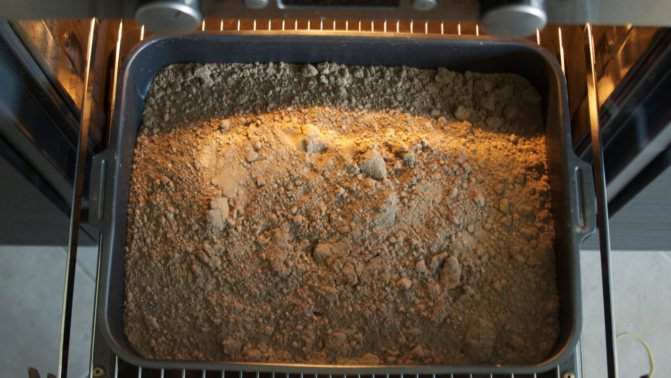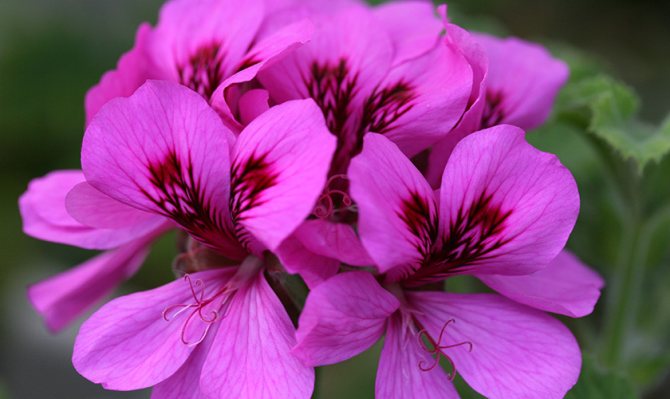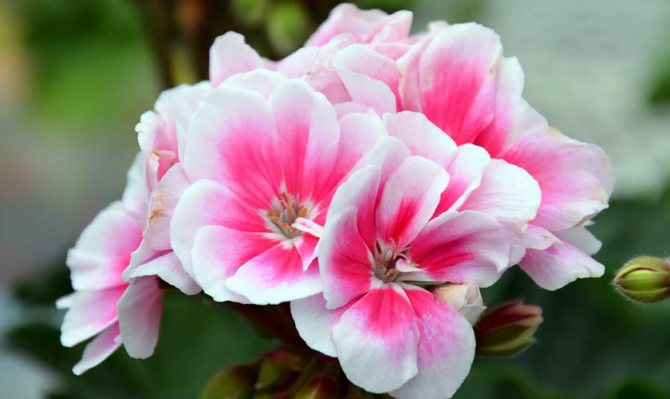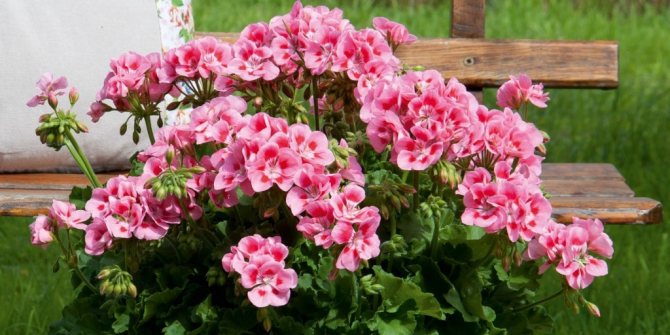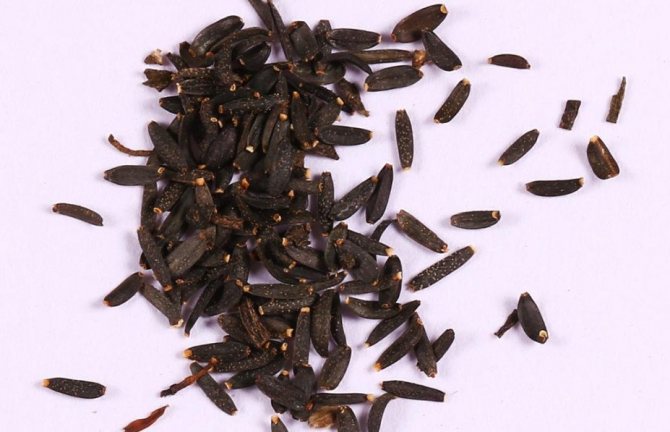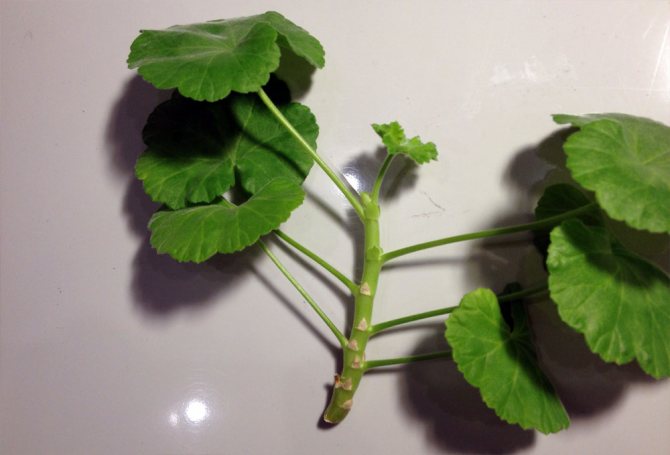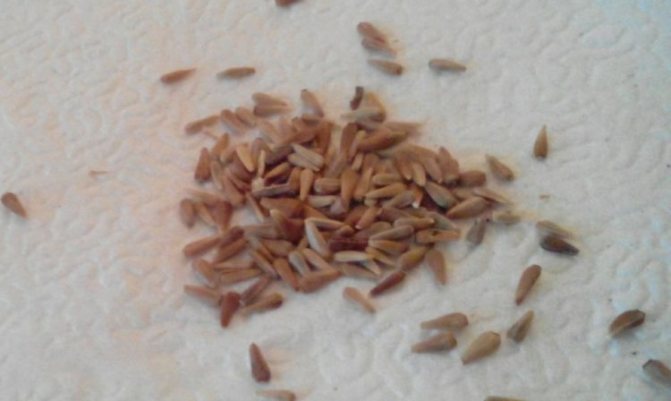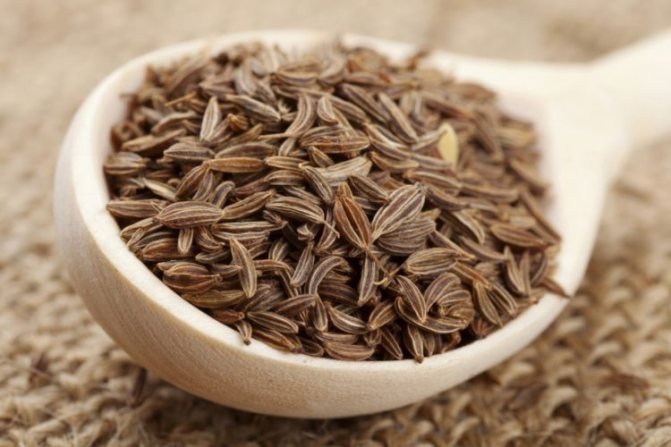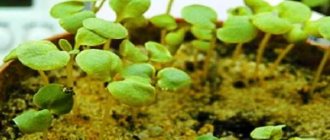Geranium (pelargonium) in the garden can decorate any area with its lush flowering. Many people grow this flower only at home. However, it is so unpretentious that it grows well in the open field. Unfortunately, in cold winters, geraniums freeze out, so for the garden it is grown as an annual plant or dug up and stored indoors until spring. If you have pelargonium at home, you can easily cut it into cuttings and get several plants from one bush. Such flower reproduction is described in detail in our article "How to root geraniums". But you can also grow geraniums from seeds, which are now sold in specialized stores.
Reproduction methods
Pelargonium reproduces in two main ways:
- seeds;
- vegetatively - by cuttings or by dividing the bush.
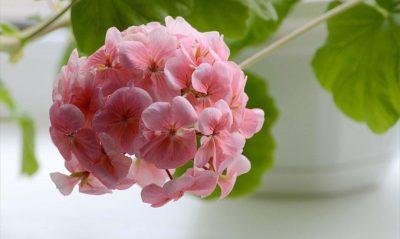
Pelargonium hybrid varieties grown from their own seeds do not inherit the properties of the parent plant. To preserve the desired traits, they must be propagated only in a vegetative way. 
Many growers are interested in growing one or another variety of pelargonium from seeds on their own. In this case, you can use both your own seeds and purchased ones. Plants obtained from seeds flower better and much more abundantlythan the pelargonium that was grown from cuttings.
Growing pelargonium (geranium) from seeds: when and how to plant correctly, how to grow seedlings
Geranium (pelargonium) in the garden can decorate any area with its lush flowering. Many people grow this flower only at home. However, it is so unpretentious that it grows well in the open field. Unfortunately, in cold winters, geraniums freeze out, so for the garden it is grown as an annual plant or dug up and stored indoors until spring. If you have pelargonium at home, you can easily cut it into cuttings and get several plants from one bush. This flower reproduction is described in detail in our article "How to root geraniums." But you can also grow geraniums from seeds, which are now sold in specialized stores.
When to sow pelargonium seeds
From the emergence of seedlings to the flowering of geraniums, you will have to wait about 5-6 months. Therefore, in order to get flowering in early summer, it is necessary to plant pelargonium seedlings in January, February or early March.
Pelargonium grown from seedlings will bloom magnificently and beautifully all summer until the frost.
If, when sowing seeds for seedlings, you are guided by the phases of the moon, please note that favorable days in 2019 according to the lunar calendar:
- in January: 10th, 15th, 16th;
- in February: 7, 11, 13, 16;
- in March: 10, 12, 15.
How to sow pelargonium seeds correctly
Seed preparation
Today, coated or scarified seeds already prepared for sowing are often sold. They do not need to be processed before planting. Before sowing, ordinary seeds can be soaked for a day in warm water or, simultaneously with soaking, the planting material can be disinfected. To do this, it is soaked for half an hour in a solution of potassium permanganate, 3% hydrogen peroxide solution or Fitosporin solution.
Soil preparation
As with any seedlings, the soil should be nutritious and loose. It can be prepared from peat, turf and sand (1: 2: 1).A week before use, such soil must be spilled with boiling water or disinfected with a solution of potassium permanganate (you can warm it up in the oven).
The easiest way to buy potting soil at the store is by choosing seedling potting or geranium-specific potting soil.
Selection of containers
A large number of seeds are sown in a box or container. In the future, the seedlings will need to dive. To avoid picking, individual pots or disposable cups with a height of about 10 cm are selected. In each of them, it is imperative to make a drainage hole.
Sowing procedure
Geranium seeds are placed in the soil to a depth of 0.5-1 cm. In a box or container, holes for seeds are made with a distance of 3-4 cm. It is recommended to sow 2-3 seeds in an individual pot. If all sprout, they leave the strongest grown seedling, and the rest pinch (do not pull out).
Sprinkle the seeds with soil mixture, sprinkle with warm water from a spray bottle and cover with foil. Seedling containers with crops before emergence are placed in a warm, dark place (it is possible under the battery).
Every day, the shelter must be removed, airing the ground for several minutes. If the topsoil is dry, it is moistened with a spray bottle using lukewarm water.
Seedlings should appear in about one to two weeks. Seedling containers are immediately placed on the lightest windowsill. In the spring, you need to choose a bright place without direct sunlight.
How to care for seedlings?
Caring for pelargonium seedlings is no different from caring for other seedlings. It is necessary to water the seedlings after the top layer of the soil dries up, and when two true leaves appear, plant them in separate containers.
Nitrogen-containing fertilizers (urea or ammonium nitrate) are applied 10 days after the pick. When 5-6 true leaves appear on the plants, complex mineral fertilizers can be used.
Landing in open ground
When warm weather sets in and the threat of night frosts passes, pelargonium can be planted in a flower bed or transplanted into larger pots and put them on a balcony or in a garden.
A site for geraniums is chosen well-lit, with light shading.
The flowerbed is prepared in advance. In the fall, when digging, mineral fertilizers and humus are introduced into it. Clay soil is diluted with sand or peat.
How to plant geraniums correctly:
- The distance between plants should be between 40 and 60 cm.
- The holes are made so that they are 5-7 cm wider and deeper than the pot in which the flowers grow.
- The bushes are carefully removed from the containers, placed in a hole.
- The roots are covered with prepared nutrient soil and watered abundantly with water. If the soil settles after watering, you need to add some more earth on top.
For the first few days, for better adaptation of the planting, it is recommended to cover it with lutrasil or other covering material.
Taking care of pelargonium in the garden is a pleasure. The main thing is to water the flowers in a timely manner, preventing the soil from drying out and feed it with mineral fertilizers several times a season. To bloom lush and uninterrupted, do not forget to regularly pick off wilted flowers.
Features of the
What do they look like?
The ripe seed pod is brown in color. The seeds themselves are surrounded by a dense shell with a small umbrella of fluff. When the basket with seeds is ripe, it bursts, and fruits are formed in its place.
What does it take to appear?
When flowers appear on indoor plants, you need to take care of the seeds. Artificial pollination can be carried out. This requires the use of a pollen transfer needle or tweezers. In the center of the flower there are ten stamens and a pistil with a stigma. With the sharp side of the needle, carefully remove the pollen from one flower and transfer it to the stigma of the pistil from another flower. Its flower should bloom a couple of days before this procedure.Pollination in this way is possible many times.
How do seeds ripen and when to harvest them?


If pollination has occurred, after 3-4 days the column begins to slowly grow and lengthen. An elongated and pointed fruit-box is formed. Ripening, the capsule greatly increases in length and thickness. When the seeds are ripe, the fruit bursts... Oblong brown seeds, covered with long white villi, hang on thin elastic threads.
How to collect seeds at home? Seeds should be harvested immediately after ripening. It is advisable to collect seeds already from dry cracked bolls, this indicates that they are ripe. Do not wait for the moment when the box opens and the seeds fall off. They may start to sprout, making it difficult to store them.
We buy seeds
If you have to sow pelargonium with seeds, then first of all you need to choose high-quality planting material. Geranium has a lot of varieties, differing in color of flowers, forms of shrubs and inflorescences. The seeds of this plant are sold in specialized flower shops and markets. You can also order online.
When material is purchased for the propagation of a flower, you need to know certain subtleties. Pelargonium seeds are sold in several types and you should be aware of this:
- there are seeds that are already peeled from the top, which accelerates their germination and are called scarified;
- there are seeds in an artificial casing. It consists of mineral and nutrients that are needed for their emergence and protect against harmful microorganisms;
- and there is also a natural group of seeds. This is a group of seeds that have not undergone additional treatment after they have been harvested.
Some of the best species that growers prefer to use to grow are the first two species. They show good germination and are more resistant to various diseases.
Despite the fact that seeds that have not been processed are cheaper, it is better to give preference to processed species, especially for beginners in this business who are going to grow a plant for the first time.
If you still have to plant unprocessed grains, then it is recommended to either soak them in warm water for a while, or rub them a little with sandpaper so that you can remove the top layer a little.
Step by step instructions: how to grow at home?
What is the time to sow?
When to sow? Sowing pelargonium at home can be done all year round, but only if additional lighting is provided. The most favorable time for sowing seeds is February or March... If you sow pelargonium later, the plant stretches strongly and blooms only after 9 months (why does not pelargonium bloom?).
Soil preparation
There are several options:
- mix in equal proportions peat, sand, humus and compost;
- combine two parts of garden land with one part of peat and sand;
- dilute peat with perlite in a 1: 1 ratio.
Before sowing seeds, the prepared substrate must be disinfected.to avoid further infestation with pelargonium. To do this, it is calcined for several minutes in the oven.
For soil treatment, you can use high quality ready-made fungicides or manganese. Then the landing should be postponed for one day.
Selection
To grow pelargonium quickly and without problems, you need to select and prepare planting material. When selecting seeds, special attention should be paid to the following signs:
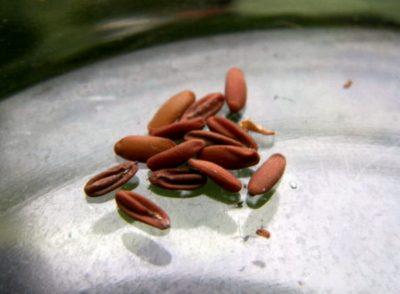

Color... Quality pelargonium seeds have a pronounced brown color. Slight dullness and light shade are allowed.- The form... The developed seeds are oblong, small depressions are visible on the sides.
- The size... The planting material is large enough.
- Shell... Pelargonium seeds are characterized by a dense leathery shell.
If the planting material has all these qualities, then it can be purchased. You should not choose seeds that have the following characteristics:
- small;
- flattened;
- deformed;
- covered with spots of different colors.
The seeds of some types of pelargonium, especially ivy, do not sprout for 2-3 months. It is necessary to remember this and not stop caring for the crops.
To maximize the shortening of the germination time, a scarification procedure is carried out... It consists in removing part of the seed coat to provide access to nutrients. This requires:
- Use a fine to medium grit sandpaper. It will help remove the surface layer without traumatic tears.
- Slowly rub the seed 2-3 times on sandpaper with a rotating motion.
How to get quality seeds or a mature plant
You can buy high-quality planting material or an adult plant in specialized stores or order it online. However, in the latter case, it is better to contact trusted firms, otherwise you can get low-quality planting material.
You can order quality seeds by mail not only in Russia, but also from Ukraine. There are also companies there that are engaged in such mailings.
You can purchase cuttings, seeds or an adult plant from familiar flower growers who are engaged in the reproduction of tulip pelargonium. In this case, it will be seen which kind of geranium is being purchased.
What does it take to plant?
How to plant? For planting seeds and successfully growing seedlings at home, you will need a greenhouse. This can be a regular seedling box that is covered with a plastic bag, a food tray with a transparent lid, or a plastic bottle cut in the middle. To provide air access, small holes must be made in the film or cover.
Sowing at home:
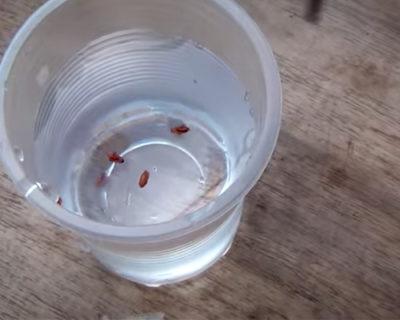

Soak pelargonium seeds in warm water for three hours, which promotes the emergence of seedlings.- Pour the previously prepared soil at room temperature in a layer of 5-7 centimeters into the greenhouse. The soil should be free of lumps and debris. Tamp the soil a little.
- Lightly spray the surface of the soil with warm water and leave for one day to warm the ground to a temperature of 21-22 ° C.
- Spread the seeds on the soil surface at a distance of two centimeters from each other, gently pressing into the soil. Seeds should be placed round side up. The flat side of the seed should be flat against the ground. Sprinkle the seeds with a thin layer of loose substrate.
- Sprinkle the seeds with a spray bottle again.
- Cover the greenhouse.
Place boxes with crops in a warm room, in which the temperature is kept in the region of 22-24 ° C. Watering the seeds is necessary as the soil dries..
We grow in peat tablets
How to grow from at home in peat tablets? Take medium-sized tablets. Arrange them in a deep container and soak in warm water until they increase in size by about 6 times. Place the grain in a special recess and cover it slightly with peat from a tablet. After that, cover the container with foil or glass and put in a warm place. The first shoots will appear after a week and a half.
Watch a video about sowing pelargonium seeds in peat tablets:
What to do next?
It is important to know not only how to grow from seeds, but also what to do with the plant after it has given its first sprout. A positive result is the fact that the first sprout of a pale green color has seeped through the soil. This suggests that all the landing rules were followed. Once this has happened, you can remove the plastic wrap and put the plant on the windowsill, where it will be enveloped by warm wind and sunlight.


Only plant leaves should be watered.In winter, this is required to be done minimally, and in summer it is necessary to provide the flower with abundant spraying. Every grower should remember that if you water the roots, then soon the plant will begin to rot. It is also important to know the optimum temperature for keeping a flower, which ranges from 10 to 15 degrees above zero in winter, from 18 to 20 degrees in summer.
Choosing the "right" pot
Small compact pots or trays 3 cm deep are suitable for germinating pelargonium. You can buy containers in special stores or make yourself.
For cultivation, boxes or pots are used. The pot in which the flower will be located is selected according to the size of the root system. The transplant is carried out only when the plant becomes cramped. (for more details on how to transplant and root pelargonium, see here). It is advisable to use clay pots. They are highly breathable and absorb moisture. You can use plastic pots, but they do not allow air to pass through and can lead to stagnation of excess water. This can lead to root rot and plant disease.
Read also: Home remedy for hawthorn
If it is possible to prepare a growing substrate on your own, then it should be used. In the purchased soil, seedlings appear later, the seedlings are weaker, the bush forms thin or unnecessarily thick stems, the flowering of the plant is scarce.
Favorable conditions for growing pelargonium from seeds:
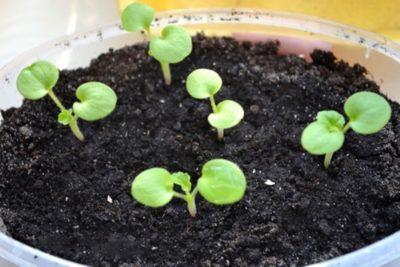

Temperature... It should be within + 18 + 24 ° C. Otherwise, the seedlings will not germinate.- Humidity... High humidity levels accelerate seed germination. Grains and seedlings must be kept in a greenhouse until the first pair of true leaves appears. It is ventilated 2 times a day.
- Backlight... When sprouts appear, the greenhouse is exposed to bright, diffused light. The length of daylight hours is at least 12 hours. You can use a fluorescent lamp for artificial illumination. Without light, pelargonium seedlings stretch out.
Pelargonium seeds emerge within 2-14 days from the moment of planting. Terry varieties with germination can stay up to 1 month.
In order for the plants to form a beautiful bush, they need to be properly cared for. Pelargonium needs timely watering, top dressing, loosening of the soil, warm climate, picking and pinching.
More details about caring for pelargonium at home can be found here.
Move to the pot
At the end of May, geraniums can be transplanted into a pot for permanent growth.
Choosing the "right" pot
First you need to decide on the material of the container:
- Plastic... Such pots have a long service life, low weight, low price, and due to the peculiarities of production, you can get products of different shapes and colors. Thanks to this, they will look favorably against the background of the overall interior.
- Clay... This material perfectly meets the requirements of geranium. The moisture in clay pots evaporates faster, thus preventing root decay. In addition, the clay washes out salts harmful to the plant from the soil. But only from this the container begins to turn black. Clay products have a porous structure that provides additional aeration, allowing the roots to breathe.
As for the size, a pot with a diameter of 12-14 cm is considered optimal, and a height of no more than 15 cm.
Soil selection


Geranium prefers to grow in loose, fertile and drained soil, with acidic, slightly acidic or neutral pH. You can purchase a ready-made substrate for indoor plants or universal soil by adding the following components to it:
Instructions: how to plant at home?
Let's figure out how to plant young shoots at home. Procedure:
- Prepare the pot, soil and drainage, sterilize everything in the oven.
- Lay 2-3 cm of drainage and part of the soil at the bottom of the container.
- Carefully remove the pre-watered geranium from the old pot along with the earthen lump. If this does not work, then you can lay the plant on its side, and then knock on the walls of the container, turning it upside down, while holding the bush.
- Examine the roots, if rotten and dried elements are found, then remove them, trying not to hurt healthy roots.
- Place the geranium with an earthen ball in the center of the new pot.
- Gradually add moistened earth between the wall of the container and the earthen lump, lightly ramming it. Shake the pot from time to time so that the soil flows down and fills the voids.
- At the end, the pelargonium must be watered and set in partial shade.
- After 7 days, move the flower to a well-lit room.
Thus, we looked at how to grow indoor geranium from seeds at home on our own. This is a simple, but very responsible business. It is important to prepare all the fixtures, choose a high-quality substrate and a pot. But the most important thing is to regularly take care of young plants in order to get a beautiful and healthy plant afterwards.
Watering correctly
Improper watering can cause disease and even death of young plants.
- Do not over-moisten the soil... This leads to blackleg, a disease that develops rapidly and destroys the seedlings. To avoid this, it is imperative to make a drainage layer and holes for the drainage of excess water in the containers for planting.
- It is required to observe the watering regime... Seedlings are watered as the soil dries up, being careful not to flood them. After picking in separate containers, the plants are watered no more than twice a week. In winter, the frequency of watering is reduced to once every seven days.
The first time they feed pelargonium two weeks after the pick. For this, fertilizers are used for flowering plants with a rich content of potassium and phosphorus. The frequency of dressing is once every two weeks. In winter, feeding is stopped. You can find out more about how to feed pelargonium here.
Watch a video about watering and feeding pelargonium seedlings from seeds:
Useful video
We suggest you watch a video about planting geranium seeds:
If you find an error, please select a piece of text and press Ctrl + Enter.
-Music
Features of the
Geranium is an outdoor cold-resistant perennial. The name comes from the Greek word for "crane", as the ripe seed pods are shaped like a crane's beak.


It grows in temperate climates, in European countries and in the United States of America. Leaves are pinnate and finger-like, indented, of various shapes. The flowering is rather modest, with two or three flowers on high peduncles. On the territory of the Russian Federation, there are about forty varieties of this plant.
Cultivated varieties can grow without transplanting, without losing their decorative properties, from 8 to 15 years in one place. Terry species were bred, as well as with yellowing and reddening leaves in autumn. Unlike geraniums, pelargonium is thermophilic.
The name of the plant is also associated with the elongated shape of the fruit, similar to the beak of a crane. Only in this case it is already a Latin word.
At home, in South Africa, pelargoniums are perennial shrubs or grasses. In the climatic conditions of Central Russia and the North of Russia, it is more often grown as an indoor potted crop or as a garden annual, through seedlings. Pelargonium leaves are slightly dissected, finger-like, evergreen. It blooms profusely and very beautifully: flowers of medium and large size, of a wide variety of colors, collected in large lush umbrella-shaped inflorescences.
These are the main differences between pelargonium and geranium. But, since the name "geranium" is more familiar and widespread, it will be used in the future to refer to both plants. In general, both of them are unpretentious, do not require special care, and even the most inexperienced novice florist can easily grow them. Propagated by dividing the bush, cuttings, as well as sowing seeds, which you can buy in flower shops or try to get it at home.
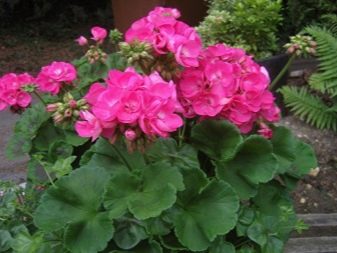

The best varieties of tulip pelargonium
| Variety name | Inflorescence shape | Foliage shape | Bushes size |
| Pelargonium Helma | The inflorescences are large, in which there are up to 40 orange-red tulips | Foliage pale green, slightly carved | Dwarf variety |
| Conny | Neat oblong flowers of bright red color | Carved foliage, emerald green, velvety | Dwarf variety, small in size in height and width |
| Tmma fran bengtsbo | Elongated pinkish-white flowers | The leaves are elongated, pale green, slightly curling upward | The variety is high, up to 0.8 m in height, quite bushy |
| Patricia andrea | The flowers are in the form of a small tulip, red-pink hue | The foliage is shiny, dark emerald, the edges are carved | A variety of standard sizes in height and width |
| Red pandora | The flowers are bright pink with red veins, the inflorescences are lush | Foliage of a juicy emerald color, velvety | Medium sized but responsive to feeding |
When to sow?
First of all, you need to pay attention to the fact that geranium seeds must be viable, of high quality, obtained from a healthy plant. Even with good, abundant flowering, geraniums in the room may not produce seeds, pollination is essential here. To do this, the pots are placed on an open balcony, terrace, or just in the garden.
If this is not possible, you can "work as a bee", that is, with the help of a soft brush, transfer pollen from one flower to another. After the end of flowering, a seed capsule will form. When it is fully ripe and dry, the planting material is removed. You can grow seedlings in the room in any season, however, the best planting dates are in the spring, when daylight hours begin to increase. In winter, young plants need to be illuminated.
Perennial garden geraniums of various species require spring planting through seedlings or sowing directly into the ground. The flowering time is varied. For example, Georgian geranium can be seen in all its glory in mid-June, for 40-45 days.
Favorable days for sowing are determined by the lunar calendar.
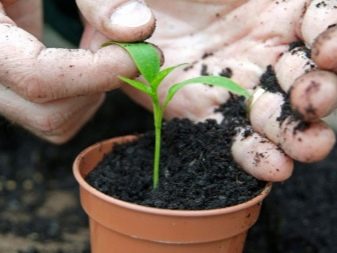

How do I get seeds?
An important question is how to get seeds from a plant so that they are suitable for planting in the ground and forming new shoots. Harvesting should be done from a mature plant in mid-summer or early fall. You should not miss this moment, otherwise they will crumble and rot in the soil or independently create new shoots in the same pot, which will lead to a lack of space for the plant and its death. Only ripe seeds are suitable for planting; this requires putting them on paper and keeping them until they are suitable for planting.
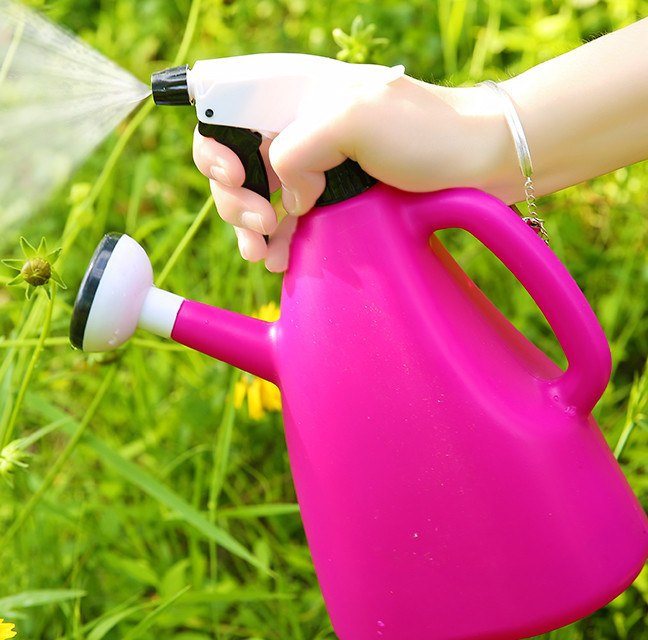

Geranium is a unique plant with many medicinal properties. For planting and growing it, you only need seeds, a suitable container, correctly selected soil and, of course, adherence to all the nuances that you could find out after reading this article.
Preparation
Before tackling sowing directly, some preparatory work needs to be done.
- Sorting seeds. Small, flattened, damaged seeds with an unusual color are discarded. Ripe seeds should be quite large, elongated, brown in color, with a dense leathery surface, without spots or damage.
- Scarification. This is scratching the surface of the seed coat with some sharp instrument (for example, a file, a nail file, or at least sandpaper).Everything must be done very carefully, only the top layer must be removed, being careful not to damage the seed. This procedure is necessary for faster emergence of sprouts. If neglected, seedlings may appear only after two to three months.
- Soil preparation. Land for planting geraniums can be bought in a specialized store, but it is better to prepare it yourself. There is nothing complicated about it. You will need to take two parts of sod soil and one each of sifted river sand and high-quality peat. Mix everything thoroughly and place in a preheated oven for three to five minutes. You can also spill the soil with hot water with manganese or use modern biofungicides (prepare according to the instructions on the package).
- Disinfection of planting material. Most often, it is advised to use a pink solution of potassium permanganate for seeds, but many prefer to soak them for 15-20 minutes in ordinary hydrogen peroxide or also take fungicides (for indoor plants).
- Soak. The disinfected seeds are poured with water at room temperature and left for two to three hours to swell.
Read also: Ivan kupala village reviews
Flower planting instructions
Now it is worth discussing an important question that relates to how to plant geranium seeds. To do this, you need to follow a few basic steps.
- The temperature of the soil in which geranium seeds can be planted should be approximately 21-22 degrees. To measure this parameter, you can use a special horticultural thermometer. If the soil temperature exceeds this indicator, then it must be placed in a cool room. If it is necessary to increase the temperature of the soil to the desired value, sprinkle it with warm water or expose it to the open rays of the sun.
- Now you can gently make the holes with your index finger. If you want to plant several seeds in one pot, then it should be borne in mind that the distance between them should not be less than 2 centimeters.
- Carefully place 1 seed in each hole, and then sprinkle each of them with a small amount of soil.
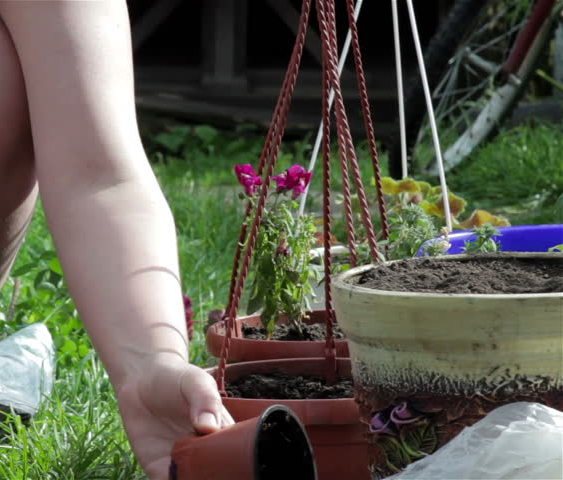

Next, you should take the final step - lightly sprinkle the soil with water at room temperature and cover the peas with plastic wrap, in which you first need to make small holes for air to pass through.
Planting methods
It is best to plant geranium seeds in flat containers, about 4-5 centimeters high. For this purpose, it is good to prepare transparent food containers with lids.
The container is filled with soil, not reaching the edge of a centimeter and a half, tamped a little by hand, leveled. Then, with a stick or finger, make small indentations at a distance of 4-5 centimeters from each other. Seeds are placed in the holes and sprinkled with a thin layer of earth. Slightly compact and moisturize with a sprayer.
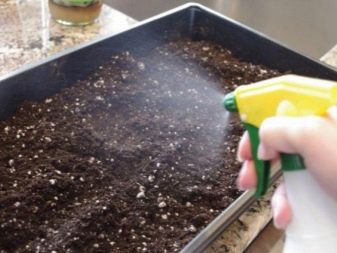

It is necessary to maintain a constant temperature and humidity of crops, to provide air ventilation. To do this, the container is covered with a lid or plastic wrap on top, in which small holes are punctured.
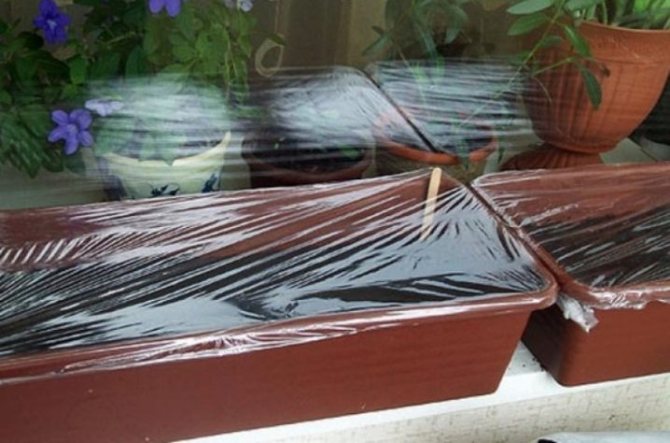

So that shoots appear sooner, you can use a simple method - germination on toilet paper. Processed, soaked seeds are laid out on a damp strip of paper, placed in a container with a lid, and placed in a warm place. As soon as white sprouts hatch, the seeds are carefully planted in the ground, trying not to damage. Also, for hardening and better growth, crops can be kept in the refrigerator for 7-10 days.
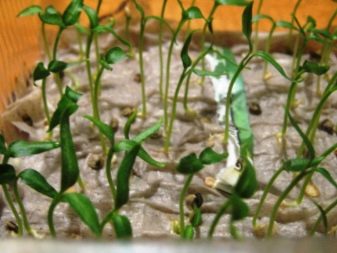

It is convenient to grow geraniums using peat tablets. In this case, the plant will not be injured when transplanted into a larger pot, the root system develops without damage. It is best to buy small tablets.To prepare the tablets for planting, they need to be soaked; for this, the products are placed in a wide and deep bowl (considering that when they swell, they will increase in size by about six times) and poured with warm water.
As soon as the peat is soaked, depressions are made in the tablets and the seeds are planted, sprinkling them with earth or peat. It should be remembered that you cannot keep crops until shoots appear on the windowsill, especially in bright sun.
However, the room temperature should not drop below 20-22 degrees.
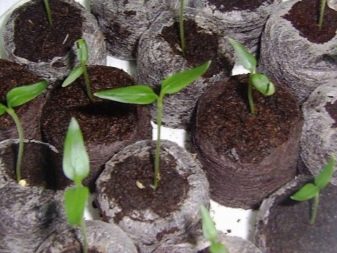

How to plant geranium seeds
Sowing geranium seeds is no different from other plants. The pot is filled with drainage, and after the soil, the seeds are laid out and covered with sand or soil.
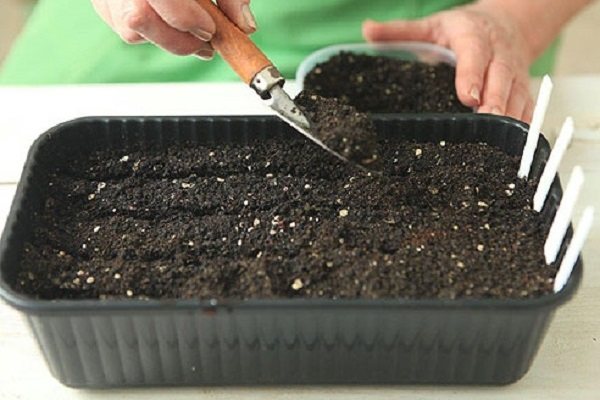

Important! The seeds should be no more than 3-4 cm deep. Otherwise, their germination will take too long.
After filling the seeds, we moisten the soil with a spray bottle, cover the container with film or glass, put the pot in a well-lit place and wait for the result. Breeding pelargonium with seeds requires a room temperature of +23 ° C. Lower rates can halt seedling germination.
How to care for seedlings?
To get healthy and beautiful plants, you need to grow good seedlings. First, the seeds should be germinated, wait for the shoots to appear. After that, the lid is removed from the container and placed in a well-lit, warm place. Timely watering is organized, since young plants can quickly die from a lack of moisture. You can water by sprinkling or with a teaspoon under each bush. At the same time, water stagnation must be avoided, this leads to decay and death of seedlings.
Also, the earth must be periodically loosened to provide air access to the roots. Of course, this should be done very carefully. Top dressing at such a young age of seedlings is not yet needed, since the soil has the necessary supply of nutrients.
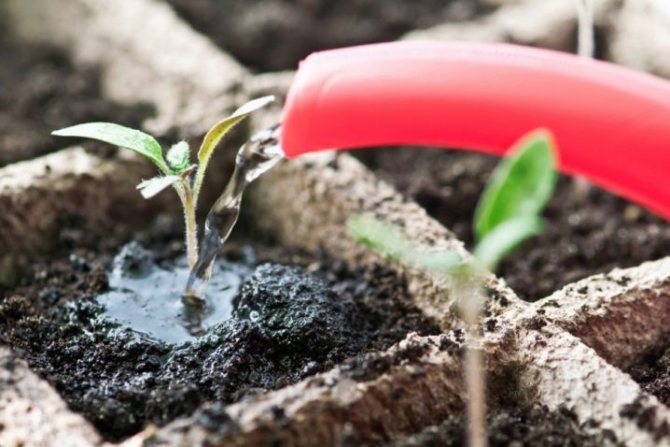

Further care of the plant
The seeded containers must be covered with a polyethylene or glass dome. It creates a greenhouse effect in the growth zone of seedlings, which best of all affects their active growth and weight gain. Remove it only before picking the sprouts into a separate container, not earlier than in the phase of 2-3 true leaves. Until that time, plants are kept in a well-lit place, with diffused light, at a temperature of at least + 25 ° C. As it dries, the soil in the dome is well moistened.
We advise you to read how and when it is better to plant geraniums at home.
After the seedlings are fully formed, then they need to be planted in a separate container, since they will soon enter into a struggle for competition for the free space of the soil. Often, it takes about 1-2 months from the moment of sowing to picking. The procedure is carried out by transshipment, while the new container in diameter should not be more than 10 cm, otherwise the excess of the substrate will inhibit the growth of geranium.
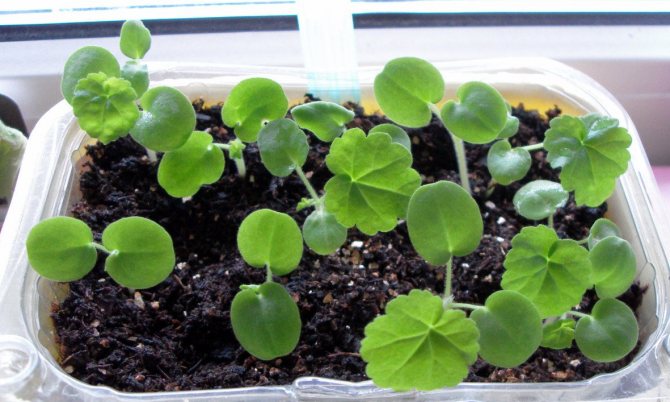

Young plants are provided with standard conditions for keeping:
- temperature regime within + 18 ... + 23 ° С in summer and + 14 ... + 17 ° С in winter;
- moderate but regular watering, the soil should be moist, while stagnant water is undesirable. The flowerpots are moistened every 2 days, in small portions; in the summer, the frequency of watering is doubled;
- well-lit place, with diffused light, protected from drafts and sudden temperature changes;
- in spring and summer, regular feeding with all kinds of organic fertilizers (every 14 days).
Important! Geranium seeds are propagated only with simple (not double) flowers. The rest of the varieties are difficult to reproduce by this method, especially in temperate and northern climates.
When to dive?
After young seedlings have two pairs of real, not cotyledonous leaves, you can start transplanting into separate pots, about 10 centimeters in diameter and 12-15 centimeters high.
Picking seedlings is a very important operation. The main thing is not to miss the right moment, and to separate the plants until their roots are intertwined. Separate with a fork, teaspoon or small spatula to care for indoor flowers. Water abundantly before starting work.
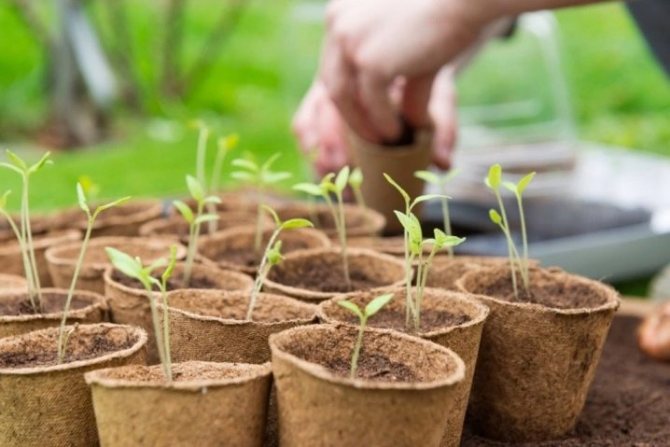

At the bottom of each pot, expanded clay (perlite, vermiculite) is laid with a layer of one and a half to two centimeters, for drainage. Then it is filled with soil by two-thirds of the volume, a dug seedling is placed in the middle, and the earth is carefully poured to the desired height. Press lightly with your fingers, tighten. Water a little, along the edge of the pot, so as not to blur the earthen lump.
In the early days, cut seedlings need shading from direct sunlight. In the future, he feels good in bright light, on the southern windows. Well-planted geraniums germinate quickly and look healthy. So that in the future the bushes do not stretch out and please with an abundance of flowers, pinch the tops as they grow.
Separately, it should be said about the seedlings of street varieties: the seedlings need to be hardened, kept in a cool, but well-lit place before planting in the ground. If possible, it is recommended to transplant it into a nursery or greenhouse.
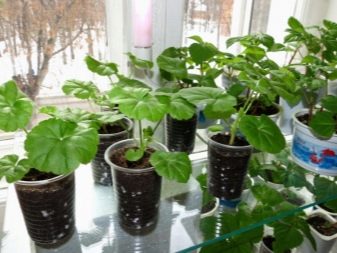

When to plant geraniums
There is no specific answer to this question. It all depends on the desire of the grower and the ability to provide the seedlings with the required amount of light. Geranium is not a particularly picky plant to grow.
Florists recommend sowing in spring or summer when daylight hours are approaching their maximum. However, if you have special equipment with which you can provide the seedlings with the required amount of light, there will be no time limit for you. Geraniums will take 3-5 months to grow to medium size.
Florist tips
Although geranium is a non-capricious plant, it reproduces well, grows and blooms with minimal care, at first the seedlings require increased attention.
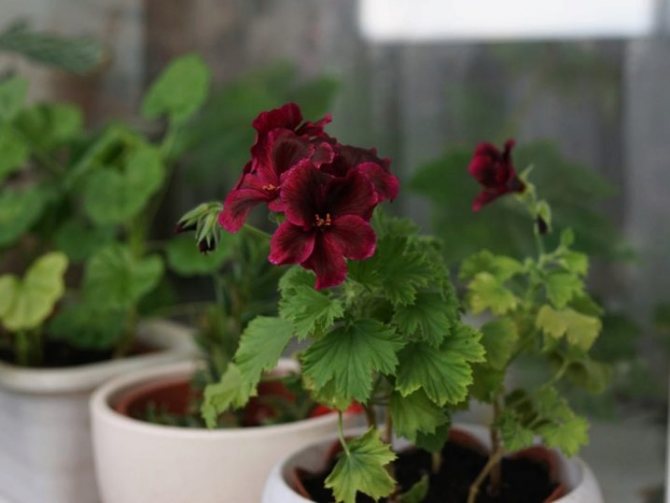

Here are some tips and secrets from experienced florists.
- Buy seeds from reliable producers, do not get hooked by bright, tempting advertisements, and do not chase cheapness.
- The composition of the store soil should not contain a lot of minerals - this is harmful to geranium. When making the mixture at home, adhere to the recommended proportions (two parts of earth and one each of sand and peat).
- Disinfect the soil and planting material.
- Scale seeds to speed up germination.
- After sowing, cover the container with a film, strictly observe the temperature regime and monitor the humidity. Water carefully, with a spray bottle, try not to overdo it. Be sure to shade the container from direct sun exposure.
- As soon as the first shoots appear, remove the film, put the container on the windowsill.
- When planting in the fall and winter, apply artificial light to lengthen the daylight hours.
- Dive when the plant has at least two true leaves.
- Plant geraniums in small pots with drainage holes; be sure to lay a layer of expanded clay on the bottom.
- Pinch the top over 5-6 leaves, so the plant will be more lush.
- Temper street geraniums before planting in open ground by exposing them to fresh air.
- Indoor varieties do not like large pots, and will not bloom until the roots fill the entire earthy ball. Therefore, it is better to replant them not too often.
By adhering to these simple recommendations, you can grow geraniums from seeds and enjoy the beauty of its flowering all year round.
For information on how to sow geraniums from seeds, see the next video.
Pelargonium, or simply geranium, is one of the most popular among lovers of home and garden plants. And this is not surprising at all, because it is a pleasure to grow it: it has excellent decorative properties and is very unpretentious in care.Knowing some of the rules and features of geraniums, even an inexperienced florist can cope with its reproduction.
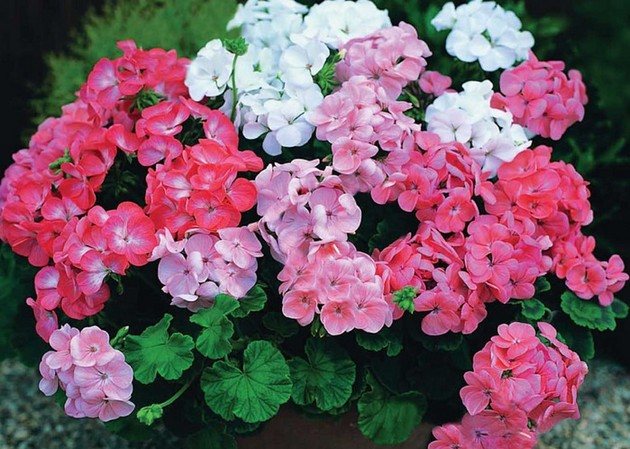

Contents of step-by-step instructions:
Useful tips from gardeners
It is not difficult to grow geraniums from seeds, but often, especially novice gardeners, undergo serious mistakes. They often lead to a decrease in decorative value, wilting and death of the flower.
To avoid them, you need to adhere to the following recommendations:
- in the cold season, the bush is hibernated (at + 15 ° C), this helps to improve the activity of bud formation;
- pinching the top of the seedling in the phase of 6-7 leaves will help to form a small compact bush;
- to accelerate the activation of seeds during soaking will help the addition of growth stimulants "Zircon" or "Kornevin" to the water (2-3 drops per 1 liter);
- water the flower only with water warmed to room temperature, otherwise it can become seriously ill;
- fertilize geranium only after abundant watering, otherwise the root system will be burned;
- iodine feeding will help to improve the flowering of the bush (1 drop of an alcohol solution of iodine should be taken for 1 liter of clean water).
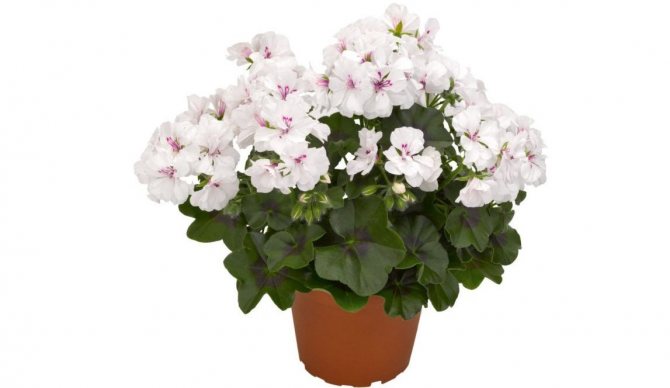

Growing geraniums from seeds is no less simple and effective way to cultivate a plant than rooting cuttings. However, in order to obtain high-quality and healthy seedlings, it is necessary to strictly approach not only the germination of the seed, but also the preparation of the soil, as well as the processing of seeds. This will not only improve the germination of the flower, but also protect it from damage by all kinds of fungi and pests.
History and interesting facts
Geranium is a perennial or annual plant belonging to the geranium family, which has more than 400 species and forms. Its homeland is hot South Africa, but pelargonium grows almost throughout the Northern Hemisphere, in regions with a temperate climate and mountainous subtropical regions. In Europe, it appeared in the 15-16th century, and immediately fell in love with flower lovers. The name geranium comes from the Greek word geranos, which means crane.


It should be noted that this beautiful plant is grown not only for decorative purposes. It has many beneficial properties: it can neutralize toxins and harmful substances, relieve headaches, and also stop bleeding and heal wounds. It is recommended to keep geranium in rooms where hypertensive patients live, as well as people suffering from nervous system disorders and insomnia.
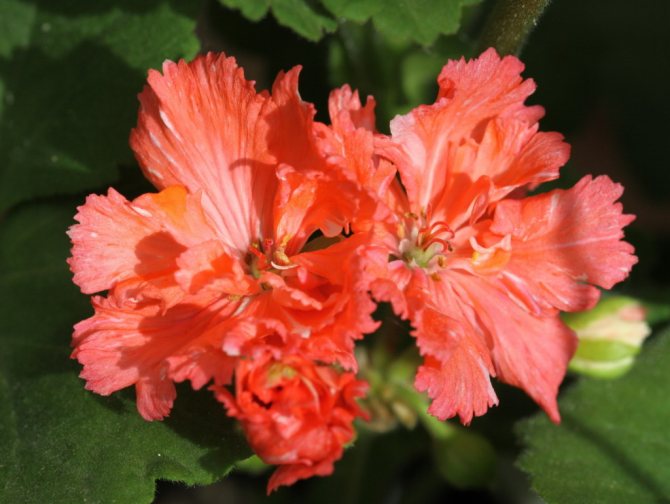

In the old days, pelargonium was endowed with not only healing, but also mystical properties. It was believed that this plant scares away snakes, so it was planted around houses in those places where reptiles are found in large numbers. In addition, fragrant sachets are often made from pink geranium flowers and placed next to worn things - in order to protect themselves from the evil eye, and at the same time scare away moths. But cat lovers with this plant should be careful. As you know, cats love to feast on home flowers, and the leaves of pelargonium contain poisonous substances that are extremely dangerous for animals.
Read also: Brushing wood in the area


Red blooming geranium
What you need to know about diving geranium seedlings and how to grow it
One of the important stages in the process of growing geraniums from seeds is diving. It is also required in the process of plant growth. Seedling picking is transplanting it from a common container into separate containers (pots).
Geranium seedlings dive approximately when the sprouts acquire at least two formed leaves. The pick is best done immediately in separate containers. For this purpose, one of the bushes is carefully taken and its roots are divided into several independent seedlings. The main thing is not to miss the right moment in the upcoming pick, otherwise it will be very difficult to untangle the horses of the plants.
The diameter of the container for the upcoming transplant should be at least twelve centimeters so that the pelargonium feels comfortable. It is better to water the transplanted geranium with a watering can, which has a thin spout.
On days when it is raining and cloudy outside, it is better to install additional lighting over the seedlings when growing. If there is not enough light for them, then this will lead to the fact that the leaves begin to die off. If affected leaves begin to appear, it is better to remove them immediately. As a result, various diseases and fungi can be prevented.
After the completion of the picking stage, as the plant grows, a special substrate should be added to the container, which can be purchased at a specialized store.
When 6-8 leaves appear on the seedlings, they will need to be pinched so that the plant does not grow too much.
How to properly care for geraniums: what she loves and what not
To grow pelargonium from seeds, you need to know some of the intricacies of flower care. It is necessary to properly care for him from the first days. Although a plant that lives at home is quite unpretentious, you should still know about some rules:
- geranium is a light-loving plant and from the first day, as soon as it is sown, it needs a fairly bright place. She loves sunshine and is not afraid of direct sunlight, however, it should not be left under ultraviolet light for a long time.
- when the seedlings begin to grow, do not water them too often. However, this does not mean that the soil in the pot must be dry. It is necessary to water the flower when dryness appears in the pot around the bush. In winter, watering is carried out less often.
- when growing geraniums, you should also take care of the optimal temperature for this. In summer, a temperature of 22 degrees is suitable, and in winter, a temperature of at least 15 degrees should be observed. For longer flowering in the pot, drainage must be provided. It is necessary so that the water in the pot does not stagnate. This will prevent the geranium from rotting. For drainage, you can use expanded clay, which is placed at the bottom of the pot when diving.
- for the plant to be healthy at home, it must be fed. This can be done using any organic fertilizer that can be purchased at a flower shop. However, you should not feed too often either. This should be done no more than three times a month.
- dried inflorescences that have already faded should be removed. Thus, you can increase the flowering period of geraniums.
How do you know that a plant is being properly cared for? This is quite simple to do. There are several signs that can help determine if pelargonium is receiving proper home care. For example, if a flower has redness on the leaves, this may mean that the temperature in the room is too low and should be made a little higher. If the leaves begin to turn yellow, you need to water the geranium a little more often, but if the leaves, on the contrary, darken, then the plant should be watered less often. In the second case, it may be better to immediately remove the bush, because it can rot. In addition, another sign of over-watering is the appearance of mold on the leaves.
When the lower leaves are noted to fall, this may mean that the plant does not have enough lighting at home. Thus, caring for geraniums at home is not so difficult and consists in moderate and timely watering, not too frequent fertilization, removing diseased leaves, dry inflorescences or dry leaves. If you follow these simple rules for caring for a flower, then the result will be good and geranium will certainly delight the grower with lush and long flowering.
How can you protect home geraniums from disease
Unfortunately, in some cases, the plant can get sick. This happens for a number of reasons and not only when grown outdoors, but also at home.For example, various pests can cause flower disease. These can be ants, aphids, or caterpillars. Geranium is very afraid of them.
Aspirin can be used to combat these pests. It is a versatile remedy that can be used on almost any type of pest. To destroy pests with aspirin, you need to take one tablet and dilute it in one liter of water. This solution must be sprayed on the roots three times a week.
Another pest control remedy is Marathon, which is good at getting rid of aphids or whiteflies. It is quite easy to use. Several granules of the preparation are poured into a flower pot and after that the plant is watered with water.
To eliminate the caterpillars, use the Monterey product. The agent is prepared according to the instructions, after which the affected geranium bushes are sprayed.
However, it is better to prevent any disease than to carry out treatment later, therefore experienced flower growers recommend prophylaxis with the help of the Messenger drug. It is able to increase the immunity of not only geraniums, but also other plants, and therefore protect them from all kinds of pests and diseases.
Description
Geranium is a low herb or shrub with a branched root system (except for species that grow in the mountains - their root looks like a rod). The structure and color of the leaves in different species also differ from each other - they can be green, grayish, bluish or even red, whole, with small or pronounced cuts, and in many varieties the leaves are covered with hairs.
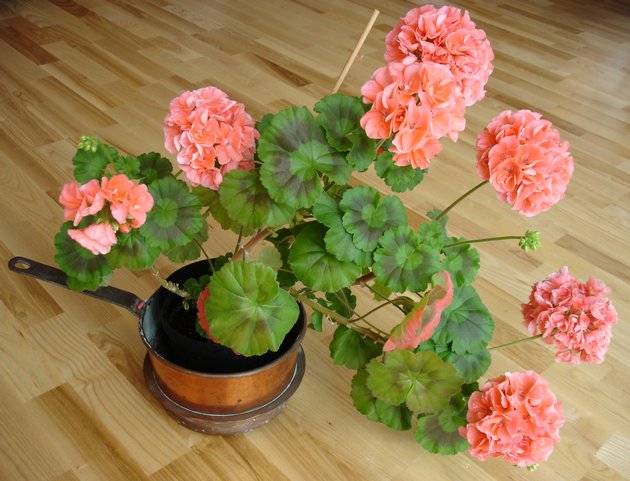

The flowers of pelargonium are large enough, have a blue, white, purple or purple hue, collected in inflorescences that look like a brush. The fruits in which the seeds ripen (this happens in late summer and early autumn) are capsule-shaped, with long valves - after ripening, they twist, scattering the seeds.
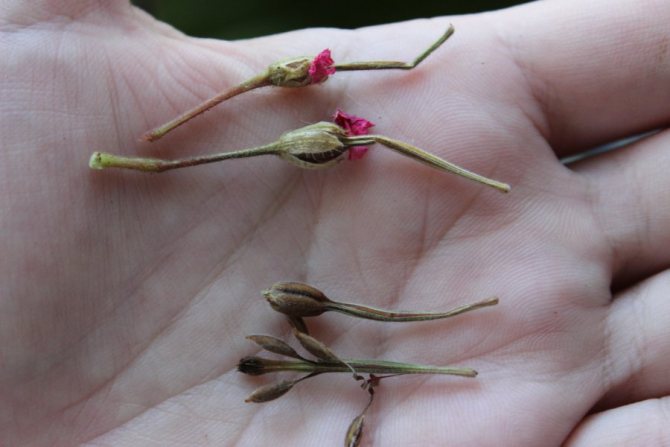

Biological description of the tulip geranium
This geranium variety was developed about half a century ago in the United States of America. in the nursery of the Andrea breeders family. What is so unusual about the tulip geranium variety? It turns out that the flowers of this variety are similar in shape to small tulips, which, throughout their flowering period, remain unopened to the end.
Flowers on this type of geranium do not grow one at a time, but are collected in inflorescences. Andrea's breeders have created several other similar new varieties of tulip geranium based on this variety. They named most of the bred varieties after their beloved women.
In Europe, these varieties of pelargonium appeared two decades after their breeding. These flowers almost immediately attracted the attention of flower growers, began to gain popularity on the European continent, but at the same time they also served as a reason for disputes.
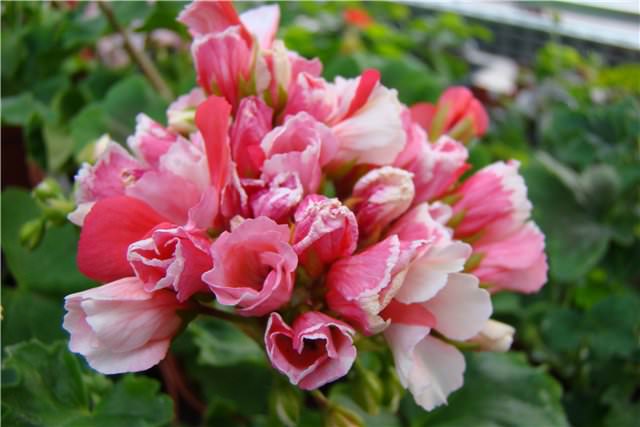

Unfortunately, these varieties of pelargonium are very difficult for breeding, because they have a peculiar structure of flowers and inflorescences, and pistils and stamens are difficult to access. Therefore, breeders managed to breed only about twenty varieties of these beautiful indoor flowers in half a century.
Many experts believe that the first variety of tulip-shaped pelargonium was born not due to the efforts of breeders, but due to an accidental mutation of varieties of pelargonium with flat pistils.
All varieties of tulip pelargonium differ in appearance and size.... There are tall specimens of such pelargoniums, in which the height of the stems can reach 0.8 m, but there are also miniature tulip-shaped pelargoniums, which seem to be real dwarfs.
These varieties differ in their growth rate, color, flower shape, as well as the number of petals in each of the inflorescence flowers. Each corolla can contain up to 9 petals, the shape of which can be round, even or serrated at the tips.The inside of the flowers is more intensely colored than the outside. Each inflorescence contains from 22 to 40 half-opened flowers.
Reproduction of room geranium
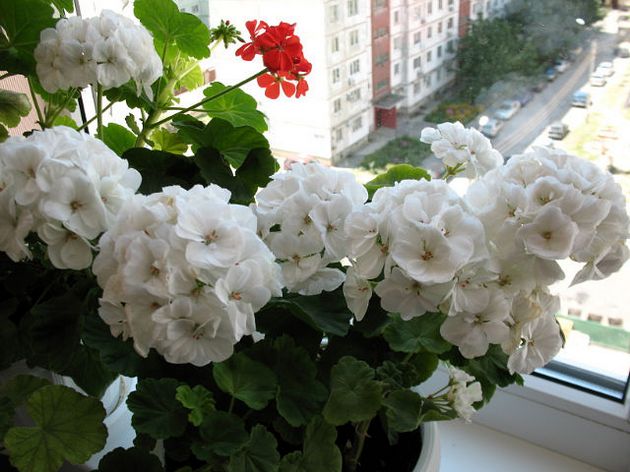

Indoor white geranium
Before growing indoor geraniums, you should know several important rules:
- the best place for a pot is a well-lit windowsill, since the plant loves sunlight very much;
- in winter, it is better to keep the flower in a cool room, but the temperature should not be lower than 10 ° C;
- in order to increase the number of shoots and inflorescences, the plant should be pinched, and dried flowers should be removed;
- almost all types of pelargonium must be cut regularly;
- with sufficient nutrition and lighting, the flower can bloom throughout the year.
Growing from seeds
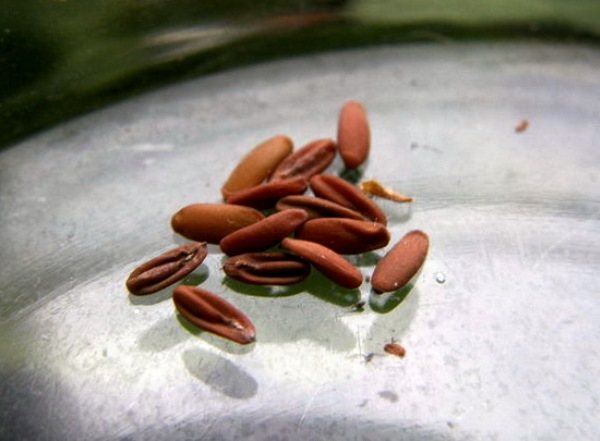

Red, white, fragrant, as well as ampelous pelargonium grows best in indoor conditions. Before starting planting, you should make sure that the seeds are free of hard leathery shells. Otherwise, they will need to be well sanded with sandpaper. Experienced flower growers do not name the exact time for planting, since with sufficient lighting, seedlings can grow in autumn and winter, but the period from November to April is considered the optimal time.


The surface of the seeds must be scratched with a knife or rubbed with an emery stone
- Before sowing, the seeds should be prepared in a certain way: treated with zircon or epinin, and soaked for three hours, no more, in water at room temperature.
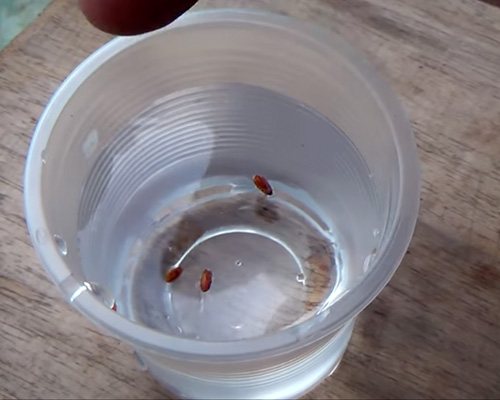

By the way, for the prevention of various diseases, you can first hold the seeds in a solution of potassium permanganate for 20 minutes, and then rinse and soak in plain water


Prepared pots with soil
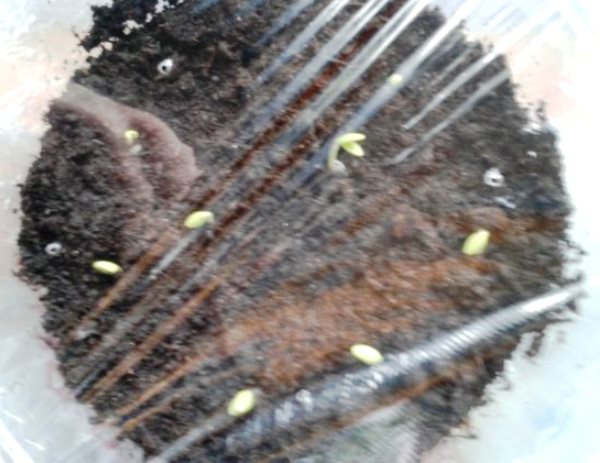

The first shoots under the film
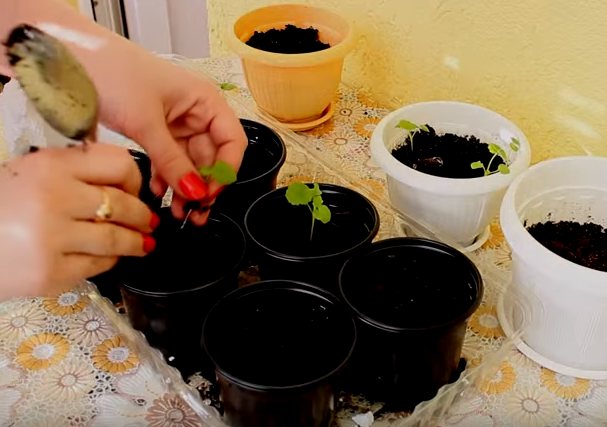

Room geranium care
Despite the fact that geranium loves moisture, it should not be in stagnant water, so a layer of expanded clay should be poured onto the bottom of the pot. Water the plants with a narrow-nosed watering can. As soon as 6-7 leaves appear on the plant, it must be pinned to stop its growth and "awaken" the lateral buds. On cloudy days, Pelargonium must be provided with additional lighting. In summer, it is better to take it outside and put it in a place protected from direct exposure to ultraviolet rays (the plant loves warm, dry air).


How to care for room geraniums
You need to fertilize the flower once every two weeks, starting from the end of March and until November, using liquid fertilizers for this. In addition, you can prepare top dressing yourself: for this, a liter of water is taken, to which a drop of iodine is added. You need to take 50 ml of this solution, and gently water the plant with it so that the liquid does not fall on the roots, but on the walls of the pot. Geranium does not need spraying.
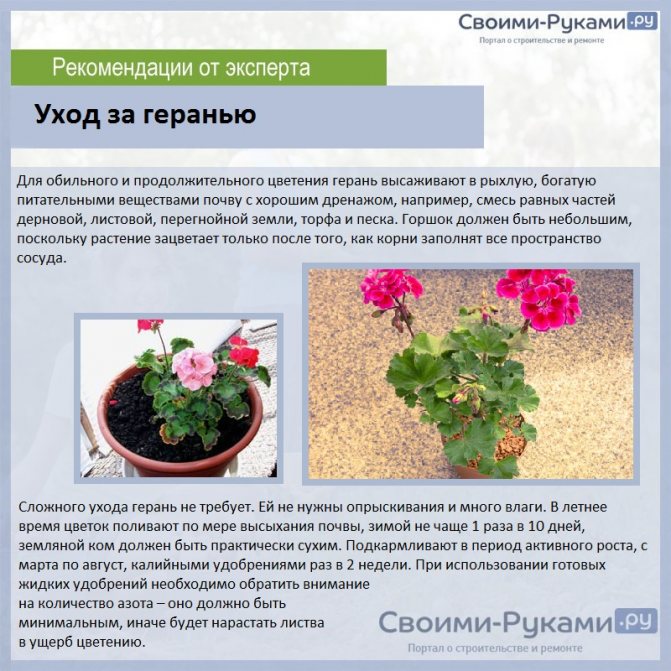

Geranium care
Pelargonium is susceptible to a number of diseases, therefore, the plants should be regularly examined for the appearance of characteristic signs. These can be yellowed leaves, reddened leaves, gray mold, or leaf fall. Usually the reason for such phenomena is too low room temperature or excess moisture. The most dangerous disease for geraniums (especially for young shoots) is called "black leg". In this case, the base of the stem begins to darken in the plant - unfortunately, there are no radical methods of combating this phenomenon, so the infected specimens will have to be destroyed.


What is needed for flowering
In order for the plant to bloom regularly throughout the season, the following procedures must be carried out:
- the plant must be regularly inspected and cut off the flowers that begin to wither and dry out. In this case, new flowers bloom faster;
- completely blooming flowers in the inflorescence must be removed immediately;
- Pelargonium cannot be kept in a draft. Also, it must be protected from gusts of cold wind, especially during flowering.


Reproduction of garden geranium
When choosing a place for growing garden geraniums, it is very important to take into account the characteristics of the variety. Most plants prefer sunny or semi-shaded places, but there are some that can only grow near bodies of water. So, in dry, sunny places, red-brown, Georgian and large-flowered species grow well, in the shade - Balkan pelargonium, in wet and shaded areas - Himalayan, marsh and meadow. The soil should be slightly acidic or neutral and fertile enough.
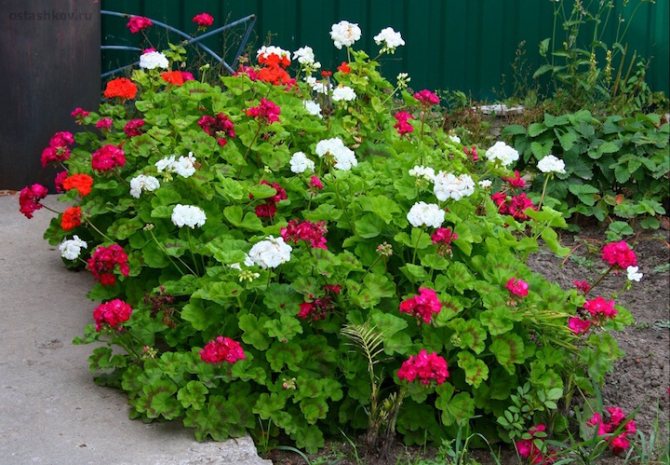

You can propagate garden geraniums both by seeds and vegetatively. The first one is rather laborious; in addition, in this case the varietal characteristics of the plant are not always preserved. In addition, it is difficult to collect seeds, and some species do not form them at all. To prevent the seeds from scattering around the site, experienced gardeners do the following: they make small canvas bags in which they place the unripe fruits of the plant, and fix them well - if the fruit bursts, the seeds will be in a kind of trap. It should also be borne in mind that plants that are propagated with seeds bloom only next year.


Garden geranium seeds
To plant geraniums, seedlings can be grown from seeds in the same way as in the case of room geraniums, and then transplanted into open ground, or simply sowed into soil fertilized with peat.
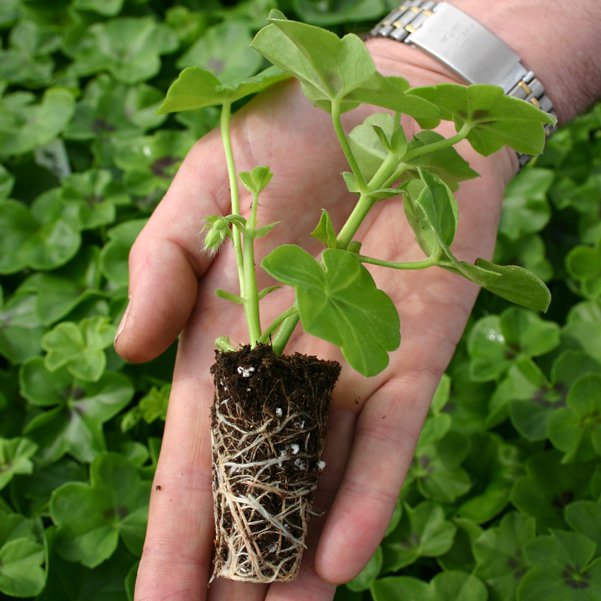

Seedling before transplanting into the ground
It is important that the planting site is large enough, since geraniums tend to grow strongly. It is also worth considering that heat-loving plant varieties do not like direct sunlight (they can severely burn the leaves), so a lace shade is best for them - for example, under the crowns of trees. Planting sprouts or sowing seeds is best done in spring or late summer.


How to propagate geranium by cuttings
Garden geranium care
The rules for caring for garden pelargonium are quite simple, and are as follows:
- the most important thing is regular watering in accordance with the requirements of a particular variety;
- in order not to loosen the soil, it is better to plant low-growing garden crops between the bushes of the plant, or to mulch the soil;
- rejuvenation or transplantation of pelargonium does not require at least ten years;
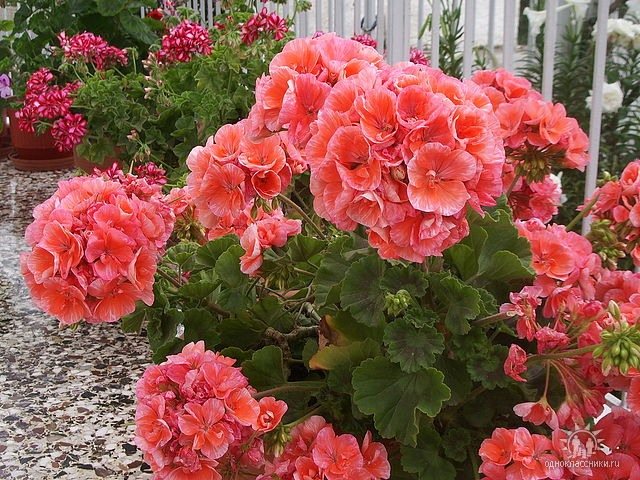

Geranium care consists of regular watering and fertilization


An open and lighted place like garden geranium
Diseases and pests
Pelargonium is practically not subject to spoilage by pests, since the strong aroma of its leaves repels insects. The only exception is spider mites, which can be eliminated with a soapy solution or insecticide. As for diseases, they most often appear if geranium grows in cold, too humid places. Some of the most common plant diseases include:
- powdery mildew.The first sign is a white bloom on the leaves, after which they begin to dry out, and the geranium dies. As a control measure, the infected parts must be removed, and the bush must be treated with a Bordeaux mixture;
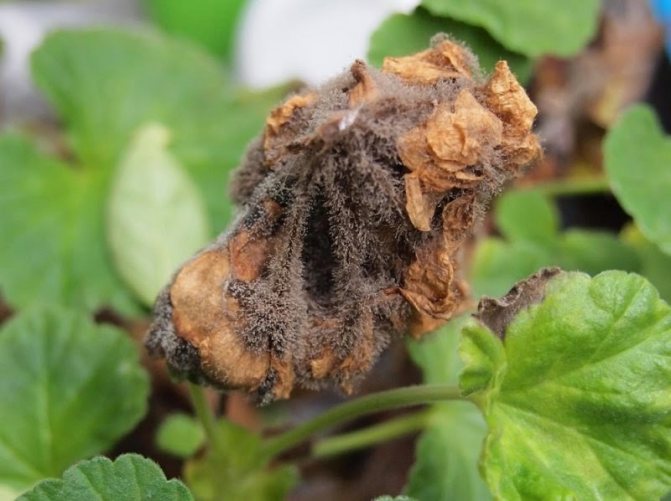

Gray rot on geranium leaves


Beautiful geranium is an easy-care, unpretentious plant that will appeal to both a beginner and an experienced florist. It can be planted on a balcony, in a garden, in flower beds or at home - in any case, its bright flowers and thick leaves will become a real decoration.
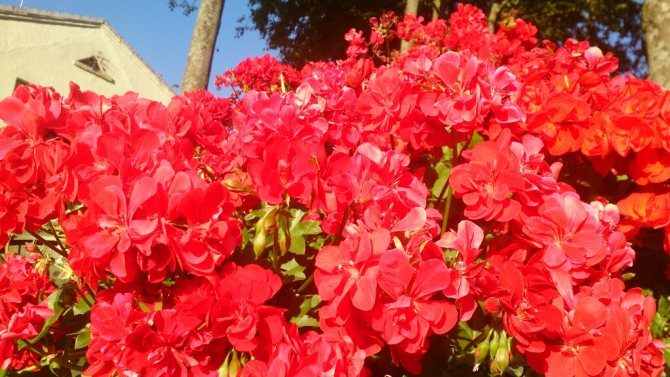

Beautiful sunny flower - geranium (pelargonium)
Video - Caring for geraniums at home
Nikolay Zhuravlev editor-in-chief
Author of publication 05/30/2016
Did you like the article? Save so as not to lose!
Prevention of diseases and pests
Usually pelargonium can be damaged by rust, gray rot, and of the pests most often it is attacked by whitefly, spider mites and mealybugs.
Usually, you can understand that a plant is sick by its appearance:
- rust appears on the foliage - a white bloom in the form of circles;
- gray rot can be recognized by gray spots appearing on the back of the foliage;
- if the plant freezes, then its stems and leaves acquire a reddish tint.
The diseased parts of the plant must be cut off immediately so that the disease does not spread to healthy leaves.
Although pelargonium tulip requires more attention than other varieties of geraniums and other indoor plants, but its high decorative effect, beautiful and abundant flowering justify the efforts of flower growers.
Optimal timing is better than planting
Pelargonium begins to bloom 3-4 months after planting the seeds. Experts recommend taking these terms into account to obtain flowering in a given period.
For those who want to please themselves with ampelous varieties for the design of a summer terrace, it is better that the seedlings are already ready in April. This means that planting with pelargonium seeds should take place in February - March.
Variety Early universal, sown in early March, will delight you with bright and abundant flowering in early May. Pelargonium Black Velvet for these purposes should be planted 2-3 weeks earlier.
When grown in an apartment, you can plant seeds all year round.
In different regions
- In the conditions of the northern region, where there is little sun and light, it is better to sow seeds in late April - May.
- In mid-latitudes, the optimal time for obtaining mature seedlings with planting in open ground is February - March.
- In the south, the plants are taken out to the terraces at the end of March, so you need to sow seeds already in December. By the beginning of spring, they will already actively bloom and delight with their beauty.
The best sowing dates according to the lunar calendar 2019
Pelargonium cannot be planted on a full and waning moon. Seedlings will be uneven, and the plants themselves will be weak, with a poorly developing root system. When diving seedlings or transplanting them into the ground, a low survival rate is noted.
The most favorable in March are: 10, 11, 12, 15, 16, 23, 24, 28, 29. And it is better to dive seedlings on 1, 2, 15, 16, 19, 20, 22, 28, 29.
In April, it is recommended to sow pelargonium seeds: 7, 8, 11, 12, 18, 20, 21, 29, 30. You need to seat: 2, 3, 7, 8, 11, 12, 16,17.
Planting seeds
It is reasonable for this to use not a common box, but separate plastic cups. Later, during transplantation, the roots of young pelargonium will be less damaged. In this case, holes should be made at the bottom of the glass and some drainage should be put in. Then fill in the soil mixture and compact it a little by hand. Pelargonium seeds are then sown, one seed per cup. Sprinkle a little soil on top and moisten the soil with a spray bottle.
The container with the sown seeds is covered with foil. At a temperature of 20 degrees, pelargonium will germinate. Every day you need to open the film so that the earth is ventilated. 5 minutes will be enough.
Most varieties of pelargonium emerge 7 days after sowing.
The most popular varieties with photos
The most popular types of pelargonium are zonal, ivy and fragrant. Plants are not particularly demanding on the composition of the soil, grow quickly, are unpretentious in feeding and are characterized by a long flowering period. Each species has the most popular varieties, which are presented in the photo below.
The Early universal variety is the most common among amateur flower growers. Time from planting seeds to flowering for more than 2 months
Zonal species of pelargonium reproduce well both by seeds and cuttings. They can be grown in containers, pots, flowerpots. They are recommended for outdoor and indoor use. The colors of the buds are rich and varied.
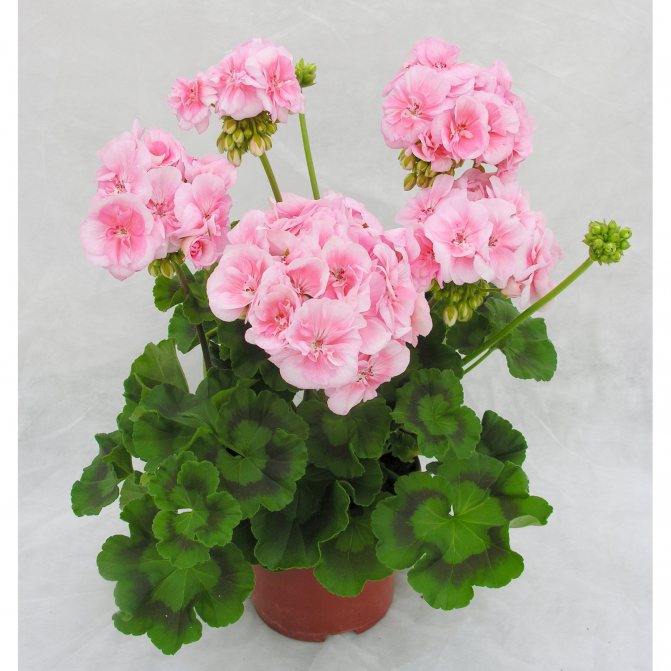

Colorama belongs to the zonal species of pelargonium. Bushes are low, with large flowers. The leaves have a characteristic dark horseshoe-shaped pattern
Colorama is preferable to grow in pots, since with a compact root system, the ground green part is very fluffy and voluminous.For the summer period, it can be planted in open ground.
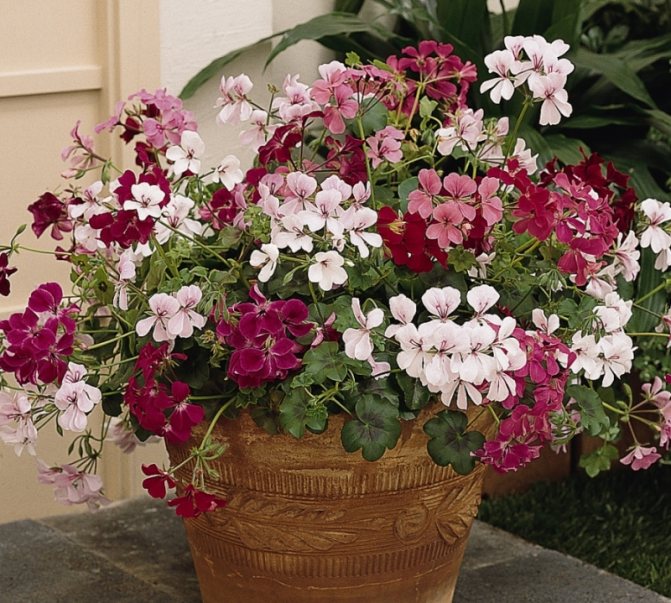

Variety Summer rain is included in the group of ivy or ampel
Thin but strong shoots of pelargonium Summer rain falls to 100 cm. The leaves are smooth, dark green, and the flowering is abundant. There are different shades. Indispensable for decorating balconies, gazebos, terraces.
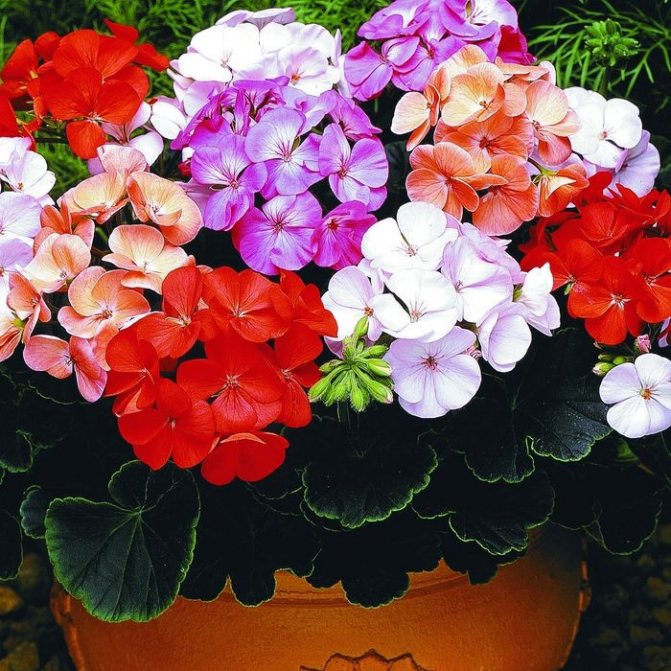

The leaves of the Black Velvet variety differ from other varieties in their chocolate, almost black color. Inflorescences are bright, velvety
Young shoots and leaves are always light green, after a few weeks they begin to darken. Most of the sale is represented by flowers with red colors.
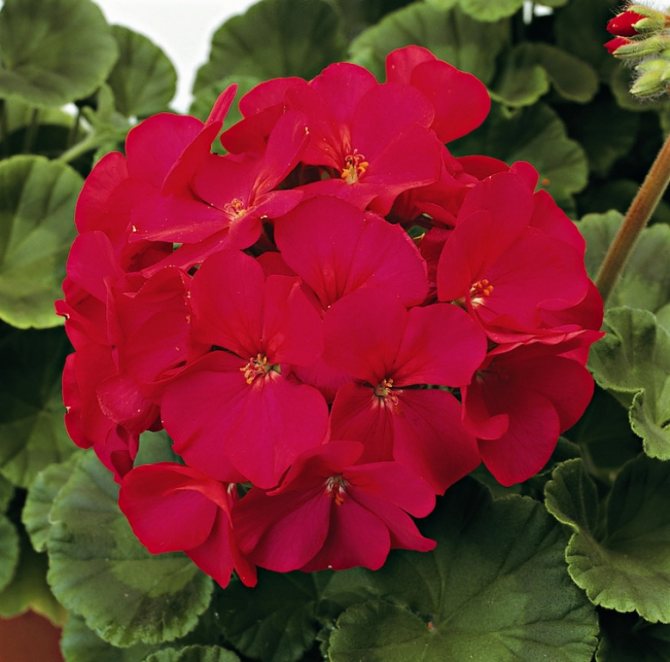

Cabaret can be identified by its luscious green leaves with wavy corrugated edges. It does not exceed 30 cm in height. At the base of each flower, yellow cores are clearly visible
Pelargonium Cabaret has spherical flowers 10–12 cm in size. Susceptible to direct sunlight, does not tolerate dry soil. It can be from dark burgundy to snow-white colors.
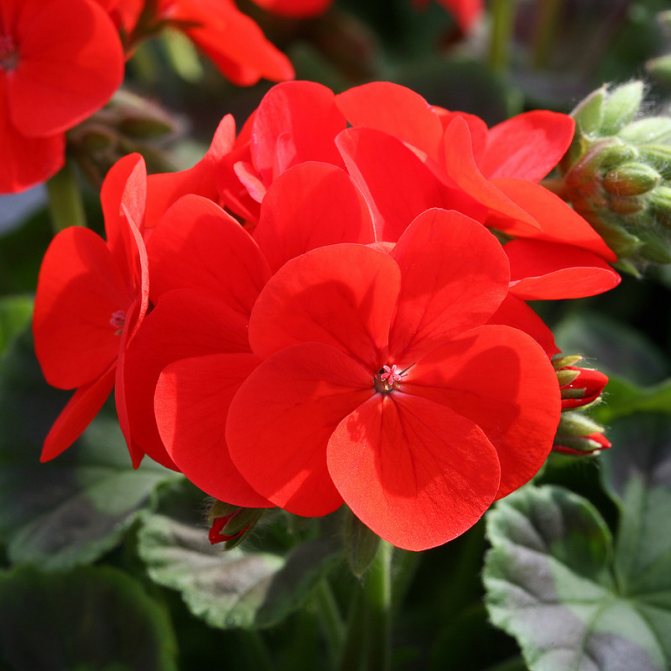

Variety Orange ice is characterized by a juicy red-orange color of inflorescences and a pale yellow-green tint of foliage.
During the flowering period, the Orange Ice bush reaches up to 35 cm in diameter. Suitable for both indoor and outdoor decor. Unpretentious, grows quickly, differs from other types in early flowering.
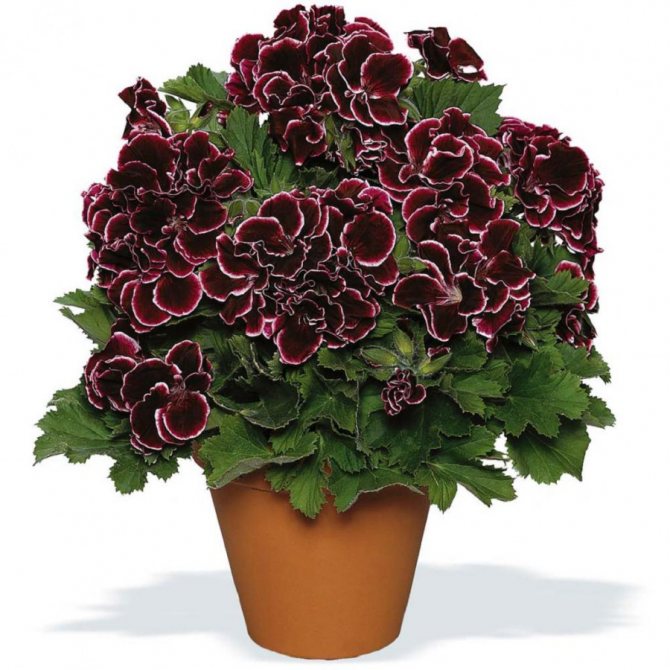

The Violet chandelier is a unique look with rich purple or blue buds
The Violet Chandelier variety is distinguished not only by abundant, but also by long flowering - from May to October. The leaves are small, with pointed edges, almost invisible under the buds.
Is it worth planting pelargonium seeds by ordering them from Aliexpress
Most customer reviews about purchasing pelargonium seeds from Aliexpress are negative. Only a few confirm that the seeds germinate really well and the flower stated in the description on the pack grows.
More than 80% of sellers send seeds of the wrong variety or of inadequate quality with practically zero germination. Therefore, to prevent such risks, it is still worth abandoning Chinese seeds and spending a little more money on quality goods from a domestic manufacturer.
Flower confusion
Two different genera "Geranium" and "Pelargonium" of the same Geraniev family cause controversy among botanists, experienced florists, and breeders. Botanists argue (and they are right) that the confusion was due to the large external similarity in the structure of leaves, flowers and fruits. But, there are many differences, and one of them is genetically fixed, which certifies that geranium and pelargonium are 2 different plants (at the genus level) of the same family.
The geranium family includes 5 genera, including the genus pelargonium (stork) and the genus geranium (crane, crane). How are they similar and what is their difference?
After the appearance of wild forms of pelargonium in Europe, a real boom in breeding new varieties began among breeders, but out of 200 species, only about 20 served as the source material for breeding. Many species were found to be incompatible with each other. Based on the basics of breeding, it is known that the breeding of new varieties is possible only within one genus. Incompatibility is explained today simply - plants are genetically different; it is impossible to cross them and get seeds.
Amateur flower growers can (without going into the jungle of science) determine which plant blooms on their windowsill or balcony - pelargonium or geranium?
Home scarification and soaking - how useful is it?
If you have purchased inexpensive seeds in a natural shell, experts recommend that they be scarified. This process is a violation of the integrity of the hard shell, which ensures better seed germination. For the first time, a professor at one of the California universities spoke about this in the 60s of the last century. In his opinion, scarification should have increased the germination rate and the percentage of seed germination.For this operation, he used a sharp scalpel, removing 0.8 mm of the outer shell at the end of the seed.
Preparing geranium seeds for planting
Today, flower growers use various options for scarification. The main thing is to act carefully, without violating the integrity of the seed itself. You can use sandpaper to place the seed between two such sheets, or while holding one edge of the seed, lightly scrape off the other edge with a sharp knife. To break the hard shell, purchased seeds in a scarified form are processed by chemical or abrasive methods. In practice, many growers do not notice the difference after scarification. Therefore, you need to try everything yourself.
The second important point for better seed germination is soaking. Prepared seeds must be left in water for at least 4 hours, or better for a day. To stimulate growth, we recommend adding a couple of drops of Epin or Zircon to the water, soaking the seeds in a weak solution of potassium permanganate. A very convenient method of soaking and germinating on wet cotton pads or napkins, which can also be treated with any stimulating and antifungal solution. In this case, you can freely control the degree of germination, and when the seeds hatch, transplant them into the ground.
What to do with them after and how much can you store?
As soon as the seeds are collected, transfer them to paper sheets, saucers or small bowls. After that, put the bowl under the canopy, where direct sunlight does not fall. The area should be well ventilated. If they are not ripe, then the temperature in the room should not be higher than + 24⁰С; and when they are dried, then t = + 30 + 35⁰C.
When the seeds are ripe and dry, they are put into a linen bag. It is advisable to knead it in your hands, and then pour it on a saucer. So they fight chaff. They just shake it out of the bag, and blow it off the saucer. Only after that, the seeds are transferred to a paper bag or linen bag. Storage temperature - + 15 + 20⁰С. The year of collection and the name of the variety are signed so as not to be confused with some other plant later.
Sowing time
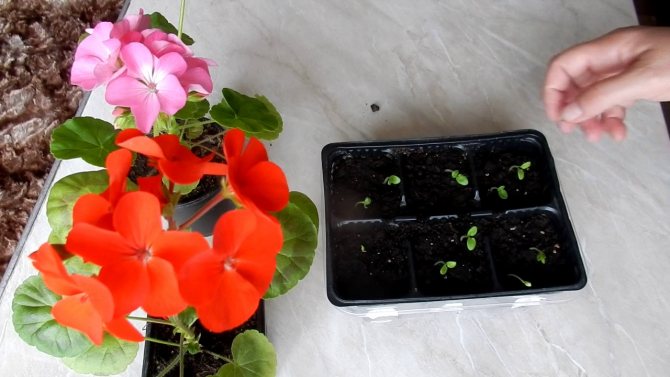

Florists do not have clear and precise recommendations for sowing room geranium seeds. The fact is that this flower is not picky and may well germinate, even planted in winter.
But in order to increase the likelihood of successful germination, spring-summer planting is still more recommended. This time is the warmest and brightest, which significantly increases the chances of success. Most growers choose early spring sowing: if the seeds are planted in March, you can get quite full-fledged young plants by July.
There are adherents of autumn sowing: these growers prefer to plant geraniums in November-December. They motivate their choice by the fact that the seeds can germinate well under artificial light, but the seedlings are more in need of an abundance of natural light. However, provided there is good artificial light, you can germinate pelargonium seeds all year round. Note that a medium-sized plant obtained from seeds reaches about 3-5 months
Interestingly, seeds of different species germinate at different times. Seedlings of zonal geranium appear the fastest - this happens within a week after planting. King geraniums germinate slowly - after three weeks. And the ivy variety can generally germinate only 2-3 months after sowing the seeds, thereby causing panic in an inexperienced grower.
Soil mix
Since the planting material is dry, planting pelargonium seeds requires loose soil. It should be of medium density and not too clayey. You can buy ready-made soil at the store, there is a special mixture for geraniums, or you can prepare it yourself at home.
To do this, you need one of the following proportions:
- peat, sand, turf (1: 1: 2);
- sand, peat (1: 1);
- perlite, peat (1: 1).
It is best to use the first version of the mixture, since with a two-component composition of the soil, it will be necessary to care for geraniums in the future more carefully.
Important! Choose high quality soil ingredients, otherwise poor soil will simply spoil the seeds.
On the other hand, for some species this does not play a special role.
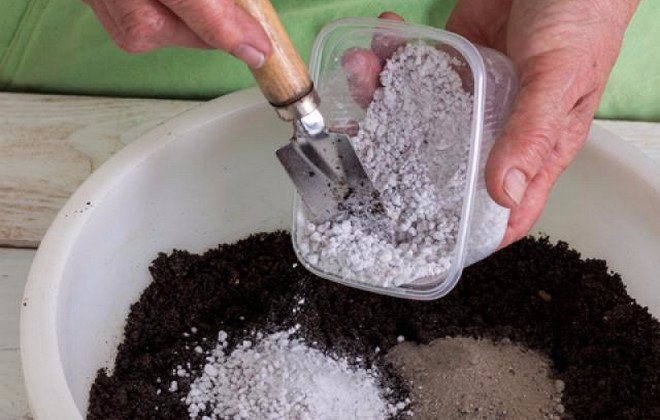

Application in landscape design
Tulip pelargonium is a capricious beauty. She can decorate balconies and verandas, as well as outdoor flowerpots, but under certain conditions. The stalk of pelargonium is very fragile, it can break from strong winds. Geranium will not tolerate drafts either. It is better to put it outside in your own pot without replanting.
From the frequent change of the pot, the plant may die. Also on the street it is more likely to become infected with insects - parasites. This sissy feels great all year round in indoor conditions.
When do they ripen?
Indoor plant lovers are aware that geranium does not always produce seeds. If they did appear, take into account the following nuances:
- An unhealthy plant will not have quality seeds.
- The hybrid is always capricious.
- He is often struck by the "black leg".
- Hybrid properties are not preserved in this type of reproduction.
Geranium gives seeds when it is properly sown. It is important to take good care of it, ensuring timely, but not abundant watering. After harvesting, the seeds of ivy or zonal pelargonium are stored dry in a warm room until they are planted in a container.
Description of the plant
Geranium is a popular ornamental plant that has been cultivated as a potting plant since the 15th century. Belongs to the Geranium family, the birthplace of the flower is South Africa. From a botanical point of view, it is an annual or perennial herb, the stem height can reach 60 cm. The leaves are very soft, villous, have a palmate-lobed shape.
Each flower consists of 5 petals, they are collected in voluminous inflorescences. Depending on the species, geranium flowers can be double, simple or smooth. The most popular varieties are with white, red or blue petals. Flowering can last up to several months.
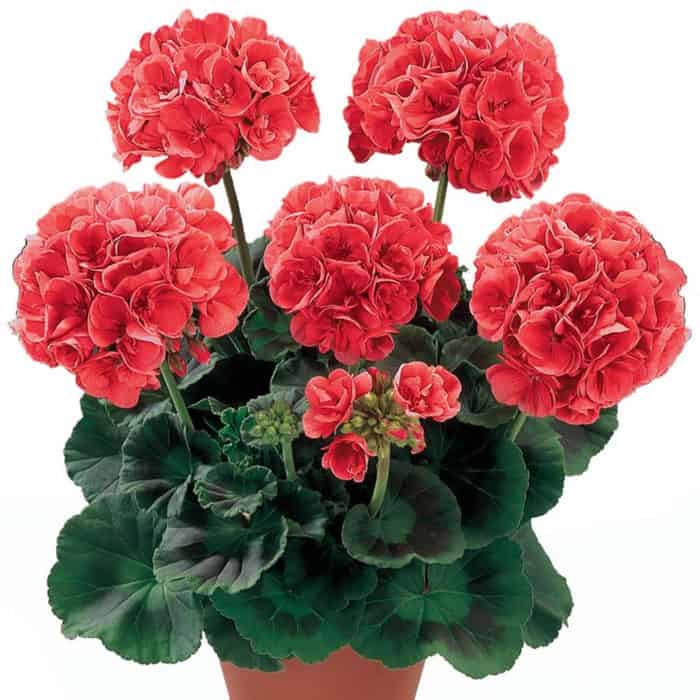

Geranium has long been used as a medicinal plant, secreting substances that have disinfecting properties, and help relieve pain. In medicine, geranium extract and oil are used. The leaves of the plant are widely used in cooking.
Preparing for landing
Despite the lack of apparent difficulty in planting a seed of geranium, there are some important factors that prevent you from getting the coveted result. The most basic of these are old or spoiled seeds that are not viable in all conditions. But even high-quality seeds can be planted without preparation so that the result will only upset the grower.
Seed processing
Geranium has two types: varietal and hybrid. You can draw an analogue with pedigree and non-pedigree animals. Seeds from non-hybrid geraniums can be harvested by yourself, however, do not hope for the exact same flower after planting. Pelargonium may well lose the characteristics of the selected variety.
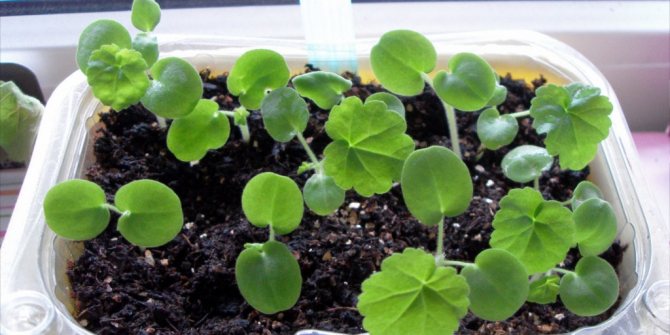

To increase the chances of a beautiful and strong plant growing as a result it is necessary to perform some manipulations with the seeds obtained in any way:
- Processing with soft sanding paper or a nail shelf. This is necessary to remove the possible external contaminated layer, which will "choke" the plant.
- Immersion in water at room temperature for three or more hours.
- Treat with zircon, which is sold in any garden store or other similar preparations.
Preparing potting soil
Soil is also a very important part of the geranium planting process. The wrong type of soil can affect the growth and development of the plant, even if the planted seeds are of the highest quality.
There can be no too strict requirements for the composition of the soil. It is important that it is not too heavy or light, and does not have a sticky clay structure. In order not to be mistaken and not to waste time in vain, it is advisable to purchase ready-made soil in the store.
Growing container
Everything is much simpler here than in the previous paragraphs. Peat pots are very relevant. The main advantage is that the seedlings in such a pot can be planted in another container without pulling them out of their original place, which will significantly reduce the risk of damaging the plant during transplantation.
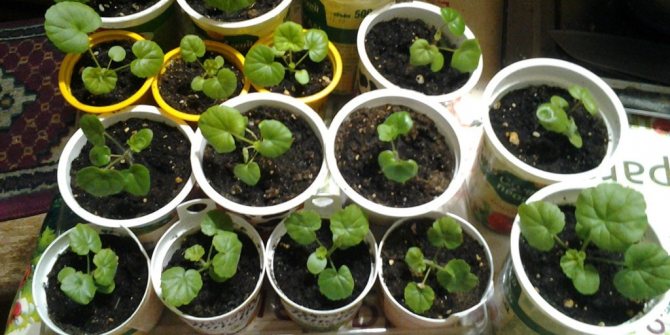

But the usual one is fine too. At first, you can place the seed of the future plant in a small glass cup, and then buy him a beautiful flower pot.
Embedding in soil
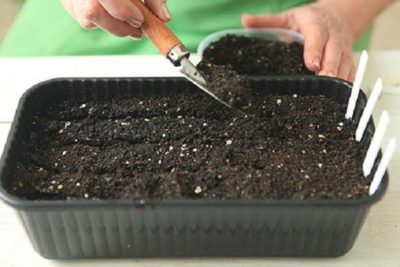

Landing arrangements are as follows:
- Before planting seeds in the ground, it should be thoroughly watered.
- Lay out the planting material on the soil, observing a distance of 5 cm, and then lightly sprinkle with earth.
- To maintain the moisture and temperature necessary for germination, cover the pot with polyethylene.
Transplant and fertilization
Have 3 leaves appeared on the seedlings? - it's time to transplant them into pots. Do not take a large pot - there is a high probability of an overflow: it should be no more than 10 cm in diameter.
It is better to transplant by transshipment - this is a less traumatic method in which the root system is not damaged. The plant is simply taken out of a small pot and placed in a larger pot, sprinkling with earth.
IMPORTANT: You can fertilize the plant after transplanting no earlier than 2 weeks later.
Any complex fertilizer with a high potassium content is suitable for feeding pelargonium - it helps to maintain a bright color of flowers and long flowering.
In summer, pelargonium can be planted in a garden or on a flower bed - this has a beneficial effect on the general condition of the flower: the plant receives more sun and watering with soft rainwater. The temperature during the day and at night is optimal - pelargonium blooms more magnificently, and the color of the leaves becomes more saturated.
There is nothing difficult in planting pelargonium with seeds, and besides, it is very interesting: you can only find out how your plant will bloom 3 months after planting. The key to success is the correct selection and preparation of seed material, as well as adherence to all care recommendations.
2 best online seed stores in Russia, tested by summer residents!
Pelargonium zonal (Pelargonium) - everyone's familiar grandmother's flower, which many are accustomed to call geranium, in fact, according to the botanical classification from the Geranium family. She is originally from South America. He loves warmth, unlike its cold-resistant relative - a real geranium, which is found in central Russia in meadows and fields.
Pelargonium zonal got its name for a characteristic border - a dark-colored annular zone - on round notched leaf blades. The leaves and stems of the plant contain essential oils, so when touched, it emits a specific smell.
Zonal pelargonium is a perennial herbaceous shrub up to 90 cm high. The growth rate of shoots is high - 20-30 cm per year. It needs to be renewed every 2-3 years.
Blooms all summer. Inflorescences are simple or double, collected in multi-flowered umbrella-caps. The palette is from white to fiery red.
| Growing rapidly. In one season, the plant adds 25-30 cm in height. |
| It blooms from late spring to early autumn with large, bright flowers. |
| The plant is easy to grow. |
| Perennial. |
Advice
If brown or yellowish spots appear on the foliage of pelargonium, and the leaves themselves have become thinner, it is likely that the watering limit has been exceeded. If the plant is waterlogged systematically, it may die altogether. To fix the problem, stop watering while watering. If waterlogging is already critical, an urgent transplant should be performed.
Avoid hypothermia of the plant: even in winter, the temperature in the room should not fall below + 10-12 degrees.
When carrying out the next transplant, do not forget about the expanded clay drainage layer. This is a prerequisite for the well-being of the plant.
Be especially careful when germinating royal geranium seeds - this plant is considered the most capricious of all types of pelargonium. In general, ampelous varieties often fail to germinate - in this case, it is still more convenient to use cuttings.
We learned how to grow pelargonium from seeds at home. Although seed reproduction is quite long, it brings good results, it is available, including for beginners. Following simple recommendations, you can successfully germinate seeds and get a full-fledged flowering plant as a result.
Seed selection and preparation
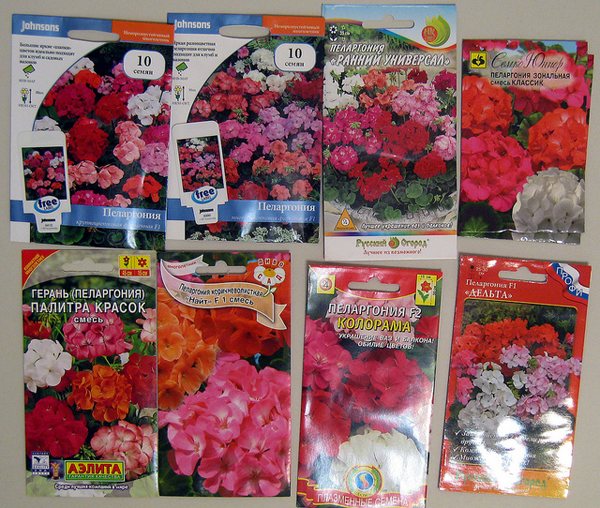

Seed propagation is best suited for zonal pelargonium: it can be rosaceous, star-shaped, tulip-shaped, carnation, etc. varieties. We advise beginners to start with zonal geranium.
But in order to get high-quality seedlings from seeds, you first need to choose the planting material correctly. Inspect the seeds and discard deformed, too small, flattened - they will not work well.
Choose the largest seeds, their color should be dark brown. The shape of a healthy seed is oblong, with small depressions on the sides. The rind of such a specimen is very dense.
Preparation
In order for the sprout to break through faster, it is recommended to prepare the peel a little, loosen it. To do this, with a knife or emery, rough paper, they lightly scrape over the seeds, scratching them.
If you use purchased seeds, they have already been treated with stimulants that activate germination. Also, the purchased planting material has been disinfected. You just have to sow it.
However, if the seeds are collected with their own hands or the packaging indicates that the planting material has not been prepared for sowing, it is necessary to carry out this very preparation. Treat the selected seeds with the root stimulant Zircon, Epin or another, for several hours then soak in warm water. Soaking can significantly speed up germination.
It is also recommended to disinfect the seeds harvested with your own hands. With purchased ones, this procedure can be carried out at will. A weak manganese solution is used for disinfection.
Varieties and hybrids of pelargonium for home cultivation
For home cultivation from the group of zonal pelargoniums, the following varieties and hybrids are recommended:
White Butterfly, Nano Violet Dwarf, Paul Pelargonium f1, South Night, Moulin Rouge, Pink, Bicolor Chandelier, Blank Grandiflora Mix, Colorama, Scarlet Chandelier and others.
If there are allergy sufferers in the family, then it is better not to grow varieties and hybrids from the group of fragrant pelargoniums indoors. In families that do not react to the aroma of flowering pelargonium, the following typical (specific) varieties can be grown, which became the basis for breeding cultivars:
Pelargonium capitate, Lady Plymouth, Citrus lime. Tomentosum Pelargonium pink; Pelargonium felt; Pelargonium curly; Pelargonium is oak-leaved.
Perfect in the interior of the apartment varieties of royal pelargonium. Large flowers collected in inflorescences create a special comfort:
Sally Munro, Mandarin, Candy Flowers Bright Red, Mona Lisa, Chocolate, Black Prince, White Gloria and others.
Even a short list of varieties and cultivars for home cultivation, given in the article, shows how infinitely rich the world of pelargonium is. Anyone wishing to tackle these old-fashioned beautifully flowering plants will definitely find their own "flower of happiness" and grow their favorite cultivar from the seeds.
Choice of place and conditions of detention
To achieve abundant flowering and harmonious plant growth, it is important to create the right conditions for its maintenance.Key points when growing geraniums:
- the plant belongs to light-loving crops, it is better to place a pot of geraniums on the southern windowsill. Direct exposure to sunlight can lead to burns on the leaves, so it is advisable to shelter during the day. With a lack of light, the leaves become smaller, the flowers are formed small;
- geranium feels comfortable in a wide temperature range from 12 to 25 ° C, so in summer the plant can be taken out to the loggia and balcony;
- any ready-made soil for ornamental plants is suitable for planting. It should be well-aerated and light, capable of passing water. If you create the soil yourself, then you can mix garden soil, sand and peat in equal proportions;
- the pot must necessarily correspond to the age of the plant and the volume of the root system. In large containers, the development of vegetative parts slows down. There should be a hole at the bottom to drain excess water;
- humidity does not affect the condition of the plant, the need for water is compensated by regular watering, it is not recommended to spray the leaves even during the heating season.
All parts of geranium exude a specific aroma, therefore, if you are sensitive to odors, it is not recommended to keep a pot with a plant in the bedroom or kitchen.
Diseases, pests and control of them
The main types of geranium diseases can be counted on one hand:
Yellowing of leaves
Reason: lack of moisture. Solution: revise the watering level, the parameters of the pot.
Lack of flowering
Reasons: lack of light, low temperature, wrong soil, large pot. Solution: changing conditions.
Leaves dry
Reasons: lack of water.
The flower dries
Reason: fungal disease.
Root rot
Reason: soil fungus. Solution: loosen the soil, remove diseased stems, use products for weeping soil.
Useful materials A selection of popular materials on the care of flower seedlings:
When and how to plant geraniums in open ground on a flower bed
Sure! Everyone is used to the fact that geranium is a home potted crop, but this does not mean at all that it cannot be grown outdoors.


As for the timing of planting geraniums in the open ground, first of all, you should monitor the weather - in the daytime it should already be warm enough, naturally, return spring frosts should be bypassed, which means that pelargoniums should be transplanted into the garden from the second half of May.
Vines and climbing plants for indoor cultivation: names and photos of flowers
Planting pelargonium in open ground is more than simple:
- chose and prepared a place;
- dug a planting hole slightly larger than the size of the pot;
- they pulled a seedling out of the pot (and did not forget to spill it before) and put it in a new place of residence;
- sprinkled with fertile soil on the sides, compacted around the seedling;
- spilled abundantly with water.
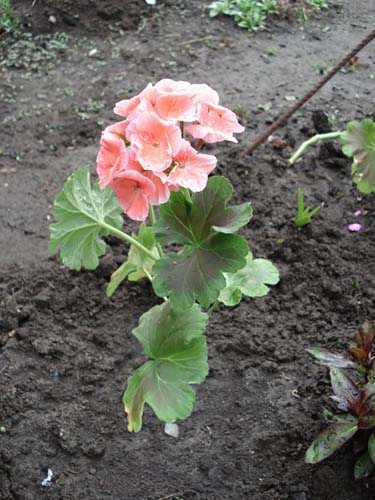

As for the planting site, the plant should not be planted in a too open place, otherwise the leaves will burn the sun and the plant will look ugly and feel unwell.
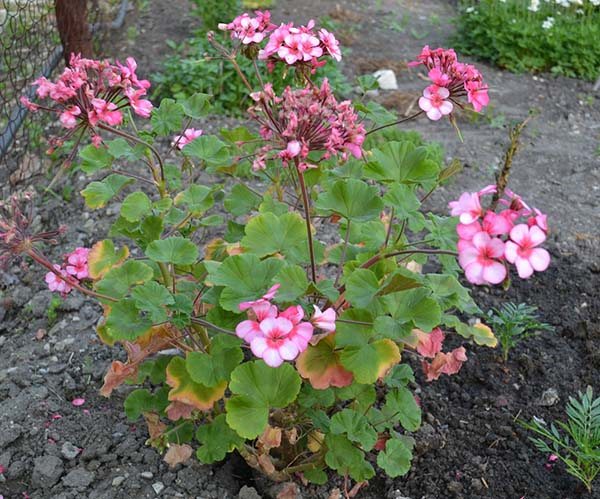

For geraniums, it is optimal to find place in light partial shade.
But! Pelargonium will bloom most abundantly in a sunnier area.
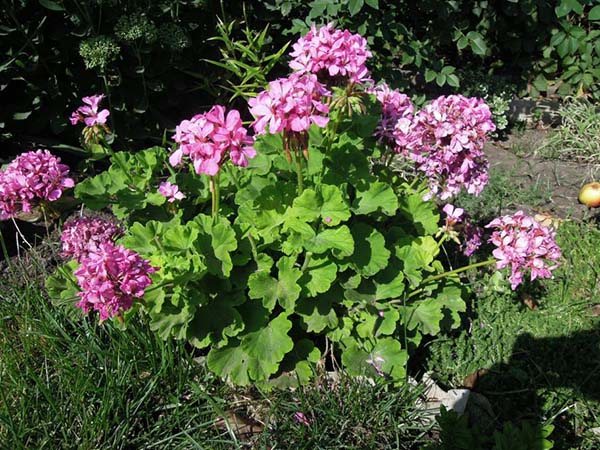

You also need to plant in those places in the garden where there is no stagnation of groundwater or rainwater.
Video: planting pelargonium in open ground - when, where and how to plant
Geranium pick
The diving process must be carried out when the second and third leaves appear on the stem. After that, you need to plant each bush in a separate vase. If this is not done, then the roots of the plants will simply intertwine and when transplanted, the geranium will hurt for a long time. Moreover, it is not a fact that she will undergo a transplant at all with severe damage to the roots.
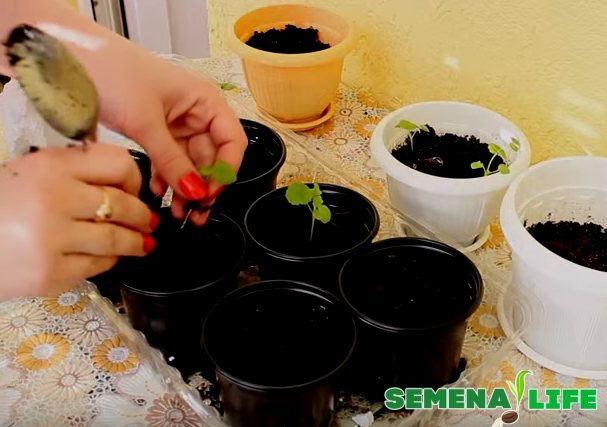

Pots with a diameter of 10 cm are suitable for picking. Two weeks later, each bush must be fed with mineral micronutrient fertilizers.
After transplanting, you need to regularly water the geraniums and make sure there is enough light.If it is not enough, then the lower leaves will begin to turn yellow. And this can lead to the development of mold at the yellowing site.
Therefore, you need to quickly remove such leaves.
Types and varieties
About 400 varieties of geraniums are known, all of them differ in the peculiarity of the bush, the color of the petals and the duration of flowering. The following types of plants are popular among flower growers:
- Ampelnaya... Used for planting in a hanging planter, has long, formed shoots hanging down;
- Fragrant... Possesses the most pronounced aroma, the shades of which may differ depending on the variety;
- Zonal... The petals are painted in several colors, which have clear zoning;
- Sadovaya... Grown in open ground, unpretentious and frost-resistant plant for the garden.
The color of geranium flowers is striking in its diversity. Almost all colors have been removed, except for yellow and blue. The work on the selection of new varieties and hybrids is being carried out to this day.
What do they look like in the photo?
Pelargonium seeds are large in size. They are hard, oblong and brown in color. Next, you can see in the photo what geranium seeds look like:
Pelargonium seeds (how to choose, preparation, planting dates)
You can buy pelargonium seeds at any flower shop. When choosing, pay attention to the shelf life of the seeds: the fresher they are, the better, the more chances of germination. The color of the seeds of pelargonium is a rich brown color, similar in shape to coffee grains, only smaller.


IMPORTANT: Large change is preferable to planting, as this is a guarantee of germination.
It is worth abandoning the acquisition of small, deformed seeds or unevenly colored and having light spots.
Many people ask the question: - When to plant seeds so that pelargonium blooms in summer? - You need to plant seeds in early March! If you move the planting dates by 2-3 weeks, then flowering will be only the next year.
Quite often, pelargonium seeds sprout for a long time or do not germinate at all. The reason is improper processing of the planting material. Pelargonium seeds are covered with a dense leathery shell. Before planting, be sure to remove it. This can be done by lightly rubbing each seed with fine-grained sandpaper without touching the inner layer. Further, to increase germination, the seeds must be treated with phytohormones according to the instructions and soaked for several hours in water. These are important secrets for successful germination.
Seed preparation
The collected seeds are pre-selected, guided by visual indications. Too small, overly flattened, elements that are knocked out of the total mass are best discarded in order to increase the chances of germination. Stains and damages are not allowed.


A handful that has become smaller must be subjected to the scarification procedure, that is, partial deliberate damage to the upper dense skin. To do this, you can use any convenient tool that you find at hand: a nail file, a file, even nail scissors with curved ends, with which they scratch grooves on the surface. This is necessary in order to facilitate the emergence of the sprout.

